Financial Analysis and Management Enterprise Report - Analysis
VerifiedAdded on 2021/02/19
|22
|5808
|21
Report
AI Summary
This report presents a financial analysis and management enterprise report, focusing on the comparison of two companies, Tesco and Sainsbury's, through the use of ratio analysis and working capital analysis. The report delves into profitability ratios (ROCE, GPM, NPM), liquidity ratios (current and qui...
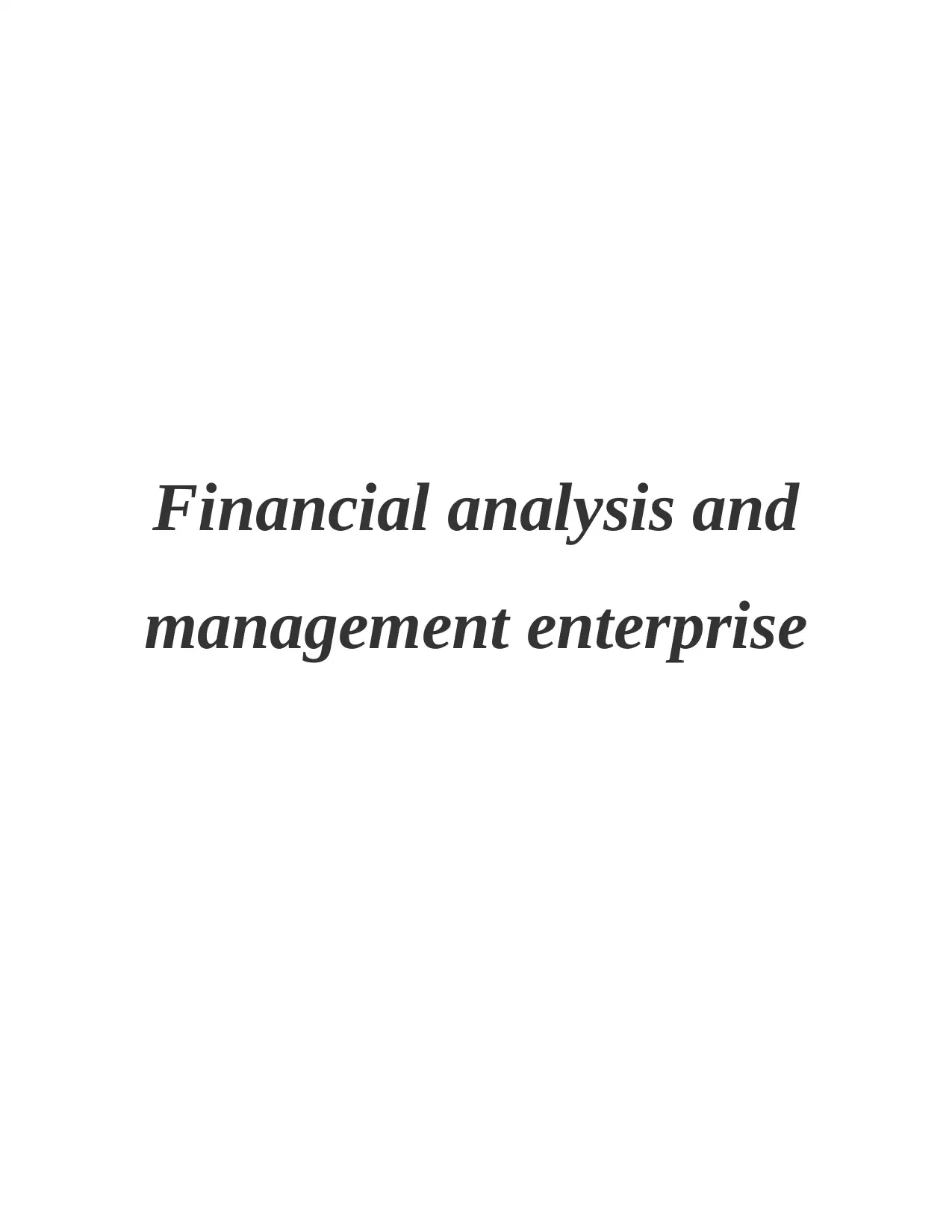
Financial analysis and
management enterprise
management enterprise
Paraphrase This Document
Need a fresh take? Get an instant paraphrase of this document with our AI Paraphraser
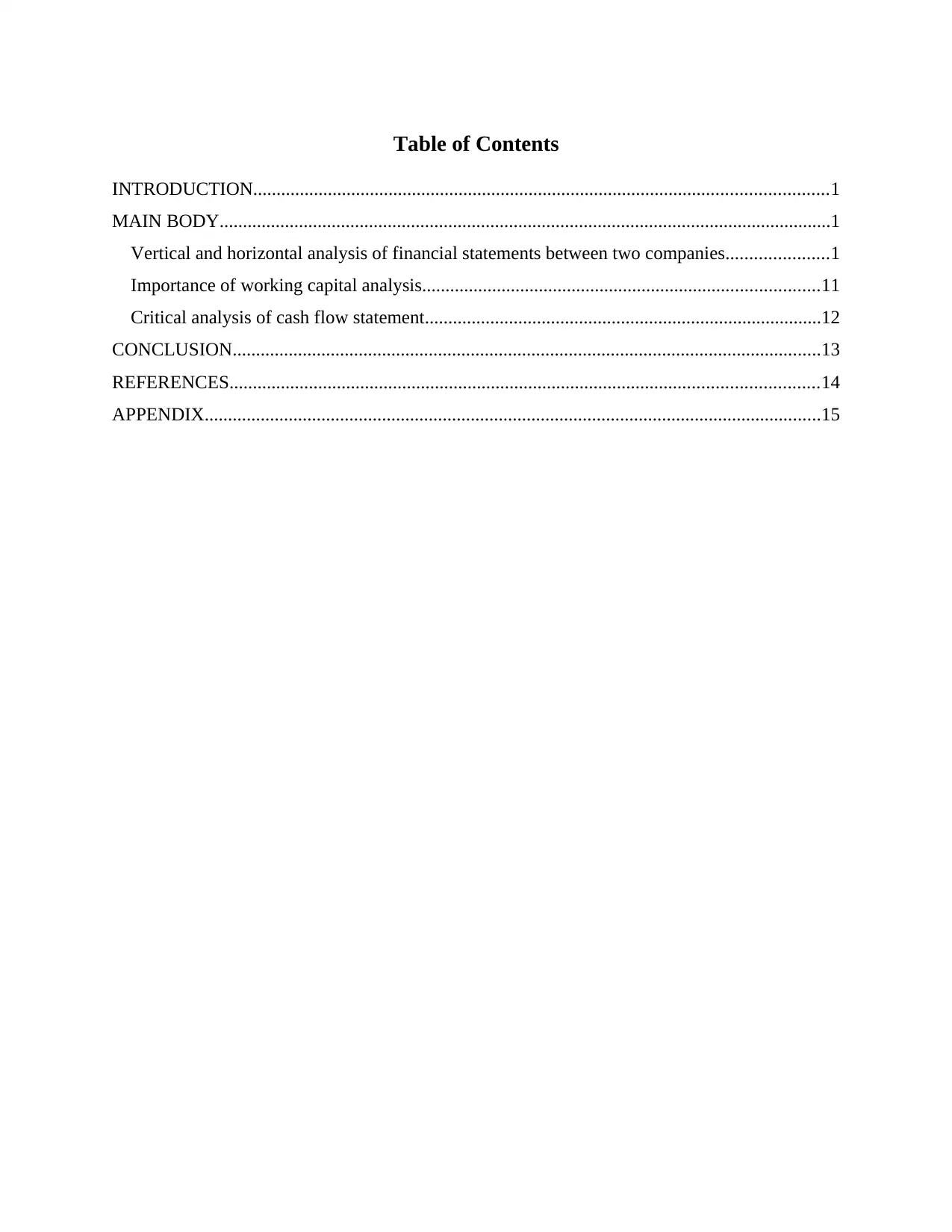
Table of Contents
INTRODUCTION...........................................................................................................................1
MAIN BODY...................................................................................................................................1
Vertical and horizontal analysis of financial statements between two companies......................1
Importance of working capital analysis.....................................................................................11
Critical analysis of cash flow statement.....................................................................................12
CONCLUSION..............................................................................................................................13
REFERENCES..............................................................................................................................14
APPENDIX....................................................................................................................................15
INTRODUCTION...........................................................................................................................1
MAIN BODY...................................................................................................................................1
Vertical and horizontal analysis of financial statements between two companies......................1
Importance of working capital analysis.....................................................................................11
Critical analysis of cash flow statement.....................................................................................12
CONCLUSION..............................................................................................................................13
REFERENCES..............................................................................................................................14
APPENDIX....................................................................................................................................15
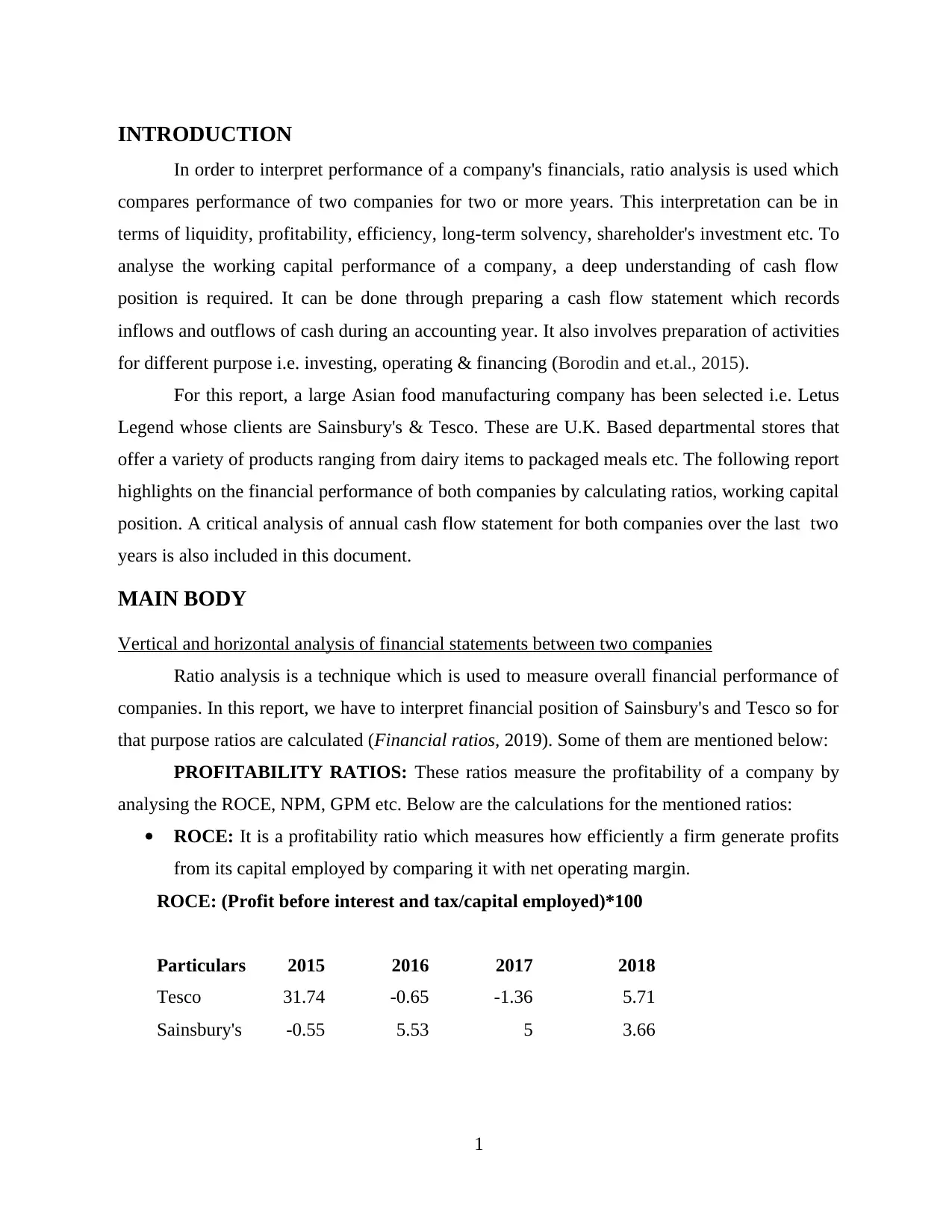
INTRODUCTION
In order to interpret performance of a company's financials, ratio analysis is used which
compares performance of two companies for two or more years. This interpretation can be in
terms of liquidity, profitability, efficiency, long-term solvency, shareholder's investment etc. To
analyse the working capital performance of a company, a deep understanding of cash flow
position is required. It can be done through preparing a cash flow statement which records
inflows and outflows of cash during an accounting year. It also involves preparation of activities
for different purpose i.e. investing, operating & financing (Borodin and et.al., 2015).
For this report, a large Asian food manufacturing company has been selected i.e. Letus
Legend whose clients are Sainsbury's & Tesco. These are U.K. Based departmental stores that
offer a variety of products ranging from dairy items to packaged meals etc. The following report
highlights on the financial performance of both companies by calculating ratios, working capital
position. A critical analysis of annual cash flow statement for both companies over the last two
years is also included in this document.
MAIN BODY
Vertical and horizontal analysis of financial statements between two companies
Ratio analysis is a technique which is used to measure overall financial performance of
companies. In this report, we have to interpret financial position of Sainsbury's and Tesco so for
that purpose ratios are calculated (Financial ratios, 2019). Some of them are mentioned below:
PROFITABILITY RATIOS: These ratios measure the profitability of a company by
analysing the ROCE, NPM, GPM etc. Below are the calculations for the mentioned ratios:
ROCE: It is a profitability ratio which measures how efficiently a firm generate profits
from its capital employed by comparing it with net operating margin.
ROCE: (Profit before interest and tax/capital employed)*100
Particulars 2015 2016 2017 2018
Tesco 31.74 -0.65 -1.36 5.71
Sainsbury's -0.55 5.53 5 3.66
1
In order to interpret performance of a company's financials, ratio analysis is used which
compares performance of two companies for two or more years. This interpretation can be in
terms of liquidity, profitability, efficiency, long-term solvency, shareholder's investment etc. To
analyse the working capital performance of a company, a deep understanding of cash flow
position is required. It can be done through preparing a cash flow statement which records
inflows and outflows of cash during an accounting year. It also involves preparation of activities
for different purpose i.e. investing, operating & financing (Borodin and et.al., 2015).
For this report, a large Asian food manufacturing company has been selected i.e. Letus
Legend whose clients are Sainsbury's & Tesco. These are U.K. Based departmental stores that
offer a variety of products ranging from dairy items to packaged meals etc. The following report
highlights on the financial performance of both companies by calculating ratios, working capital
position. A critical analysis of annual cash flow statement for both companies over the last two
years is also included in this document.
MAIN BODY
Vertical and horizontal analysis of financial statements between two companies
Ratio analysis is a technique which is used to measure overall financial performance of
companies. In this report, we have to interpret financial position of Sainsbury's and Tesco so for
that purpose ratios are calculated (Financial ratios, 2019). Some of them are mentioned below:
PROFITABILITY RATIOS: These ratios measure the profitability of a company by
analysing the ROCE, NPM, GPM etc. Below are the calculations for the mentioned ratios:
ROCE: It is a profitability ratio which measures how efficiently a firm generate profits
from its capital employed by comparing it with net operating margin.
ROCE: (Profit before interest and tax/capital employed)*100
Particulars 2015 2016 2017 2018
Tesco 31.74 -0.65 -1.36 5.71
Sainsbury's -0.55 5.53 5 3.66
1
You're viewing a preview
Unlock full access by subscribing today!
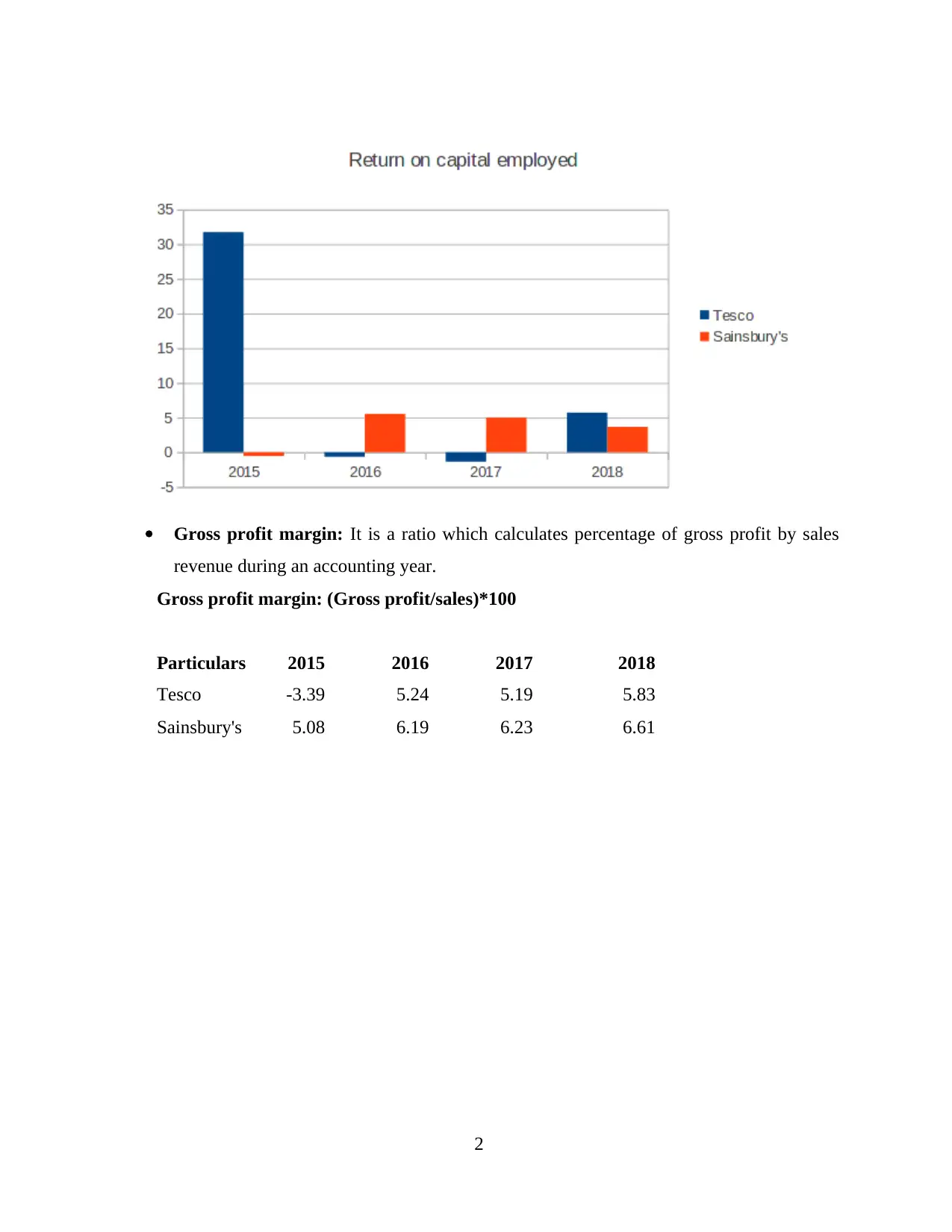
Gross profit margin: It is a ratio which calculates percentage of gross profit by sales
revenue during an accounting year.
Gross profit margin: (Gross profit/sales)*100
Particulars 2015 2016 2017 2018
Tesco -3.39 5.24 5.19 5.83
Sainsbury's 5.08 6.19 6.23 6.61
2
revenue during an accounting year.
Gross profit margin: (Gross profit/sales)*100
Particulars 2015 2016 2017 2018
Tesco -3.39 5.24 5.19 5.83
Sainsbury's 5.08 6.19 6.23 6.61
2
Paraphrase This Document
Need a fresh take? Get an instant paraphrase of this document with our AI Paraphraser
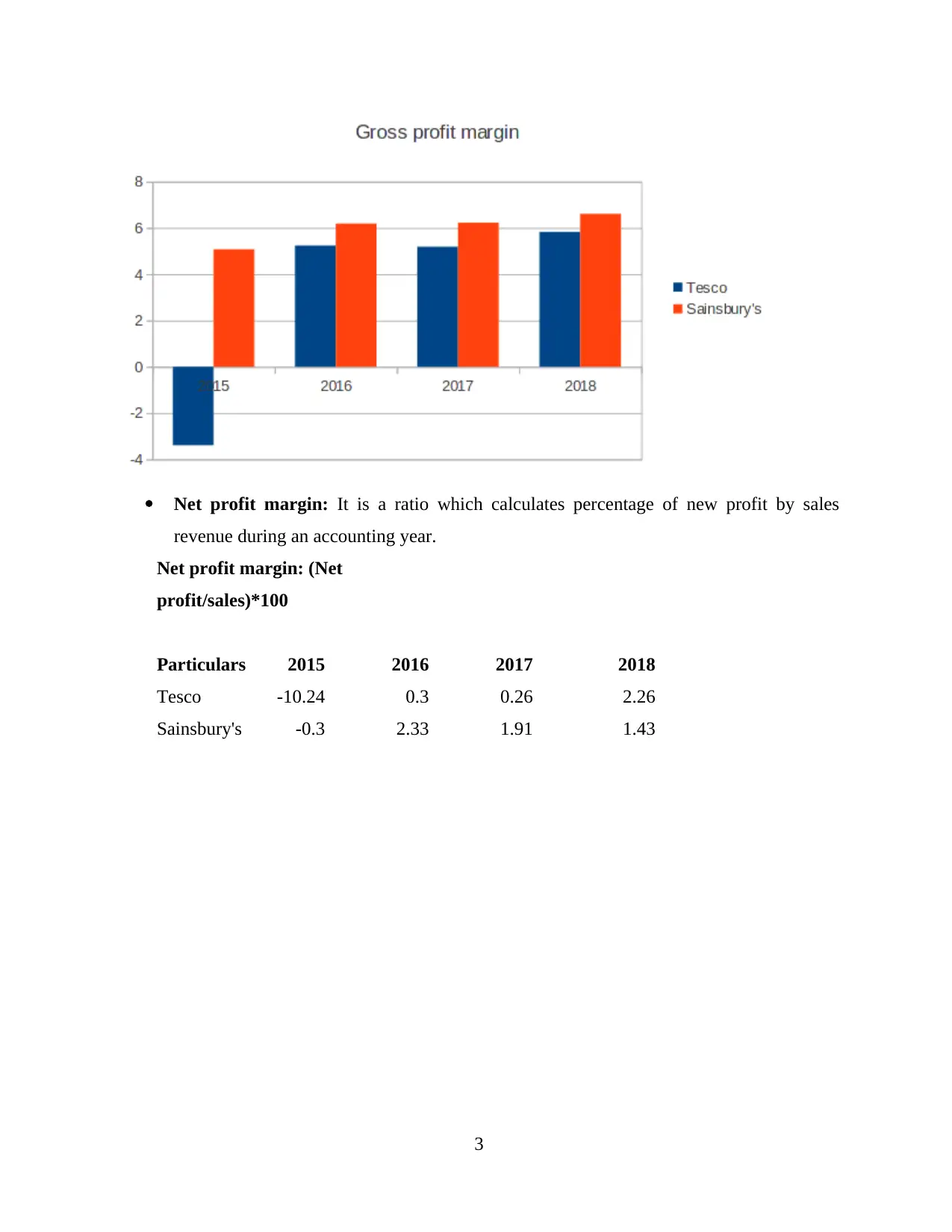
Net profit margin: It is a ratio which calculates percentage of new profit by sales
revenue during an accounting year.
Net profit margin: (Net
profit/sales)*100
Particulars 2015 2016 2017 2018
Tesco -10.24 0.3 0.26 2.26
Sainsbury's -0.3 2.33 1.91 1.43
3
revenue during an accounting year.
Net profit margin: (Net
profit/sales)*100
Particulars 2015 2016 2017 2018
Tesco -10.24 0.3 0.26 2.26
Sainsbury's -0.3 2.33 1.91 1.43
3
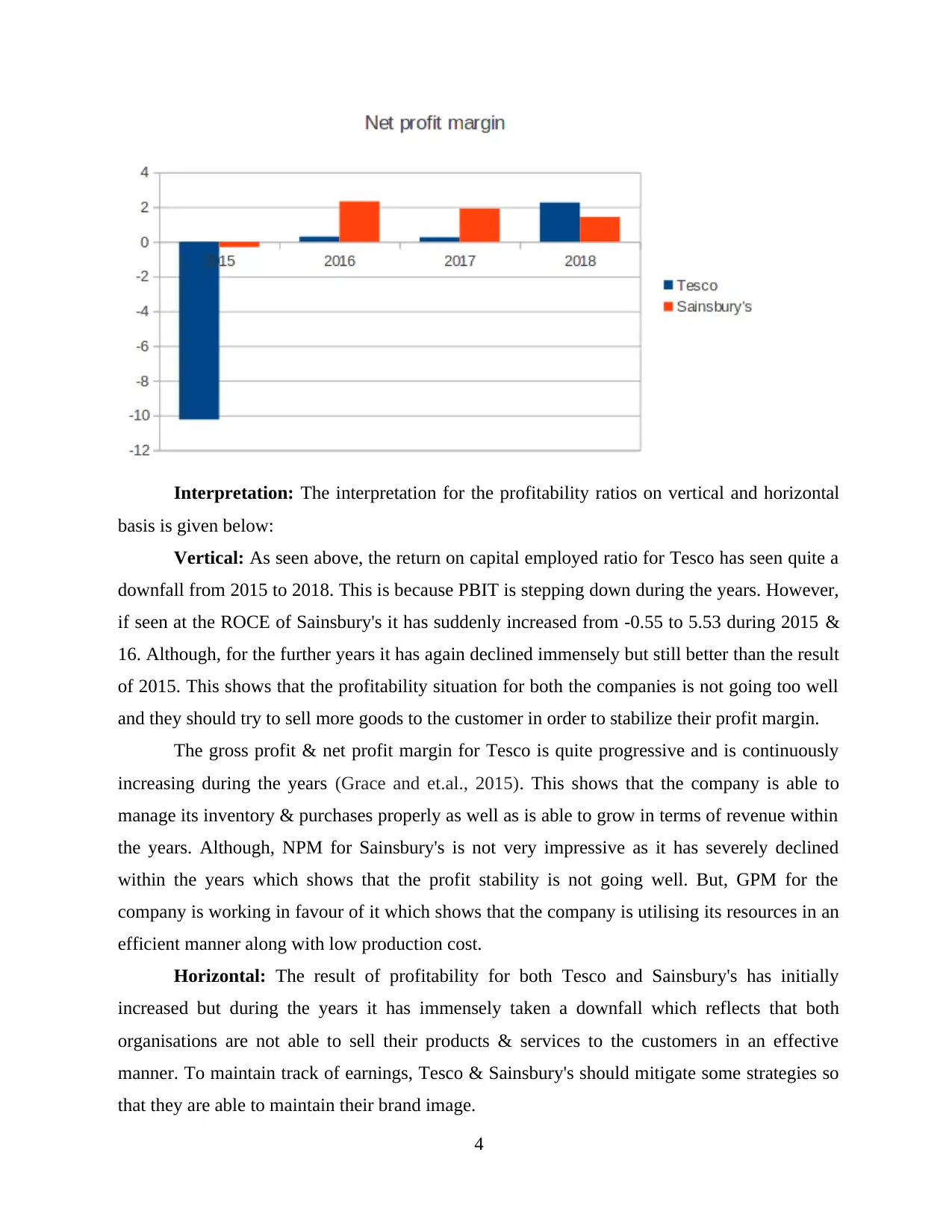
Interpretation: The interpretation for the profitability ratios on vertical and horizontal
basis is given below:
Vertical: As seen above, the return on capital employed ratio for Tesco has seen quite a
downfall from 2015 to 2018. This is because PBIT is stepping down during the years. However,
if seen at the ROCE of Sainsbury's it has suddenly increased from -0.55 to 5.53 during 2015 &
16. Although, for the further years it has again declined immensely but still better than the result
of 2015. This shows that the profitability situation for both the companies is not going too well
and they should try to sell more goods to the customer in order to stabilize their profit margin.
The gross profit & net profit margin for Tesco is quite progressive and is continuously
increasing during the years (Grace and et.al., 2015). This shows that the company is able to
manage its inventory & purchases properly as well as is able to grow in terms of revenue within
the years. Although, NPM for Sainsbury's is not very impressive as it has severely declined
within the years which shows that the profit stability is not going well. But, GPM for the
company is working in favour of it which shows that the company is utilising its resources in an
efficient manner along with low production cost.
Horizontal: The result of profitability for both Tesco and Sainsbury's has initially
increased but during the years it has immensely taken a downfall which reflects that both
organisations are not able to sell their products & services to the customers in an effective
manner. To maintain track of earnings, Tesco & Sainsbury's should mitigate some strategies so
that they are able to maintain their brand image.
4
basis is given below:
Vertical: As seen above, the return on capital employed ratio for Tesco has seen quite a
downfall from 2015 to 2018. This is because PBIT is stepping down during the years. However,
if seen at the ROCE of Sainsbury's it has suddenly increased from -0.55 to 5.53 during 2015 &
16. Although, for the further years it has again declined immensely but still better than the result
of 2015. This shows that the profitability situation for both the companies is not going too well
and they should try to sell more goods to the customer in order to stabilize their profit margin.
The gross profit & net profit margin for Tesco is quite progressive and is continuously
increasing during the years (Grace and et.al., 2015). This shows that the company is able to
manage its inventory & purchases properly as well as is able to grow in terms of revenue within
the years. Although, NPM for Sainsbury's is not very impressive as it has severely declined
within the years which shows that the profit stability is not going well. But, GPM for the
company is working in favour of it which shows that the company is utilising its resources in an
efficient manner along with low production cost.
Horizontal: The result of profitability for both Tesco and Sainsbury's has initially
increased but during the years it has immensely taken a downfall which reflects that both
organisations are not able to sell their products & services to the customers in an effective
manner. To maintain track of earnings, Tesco & Sainsbury's should mitigate some strategies so
that they are able to maintain their brand image.
4
You're viewing a preview
Unlock full access by subscribing today!
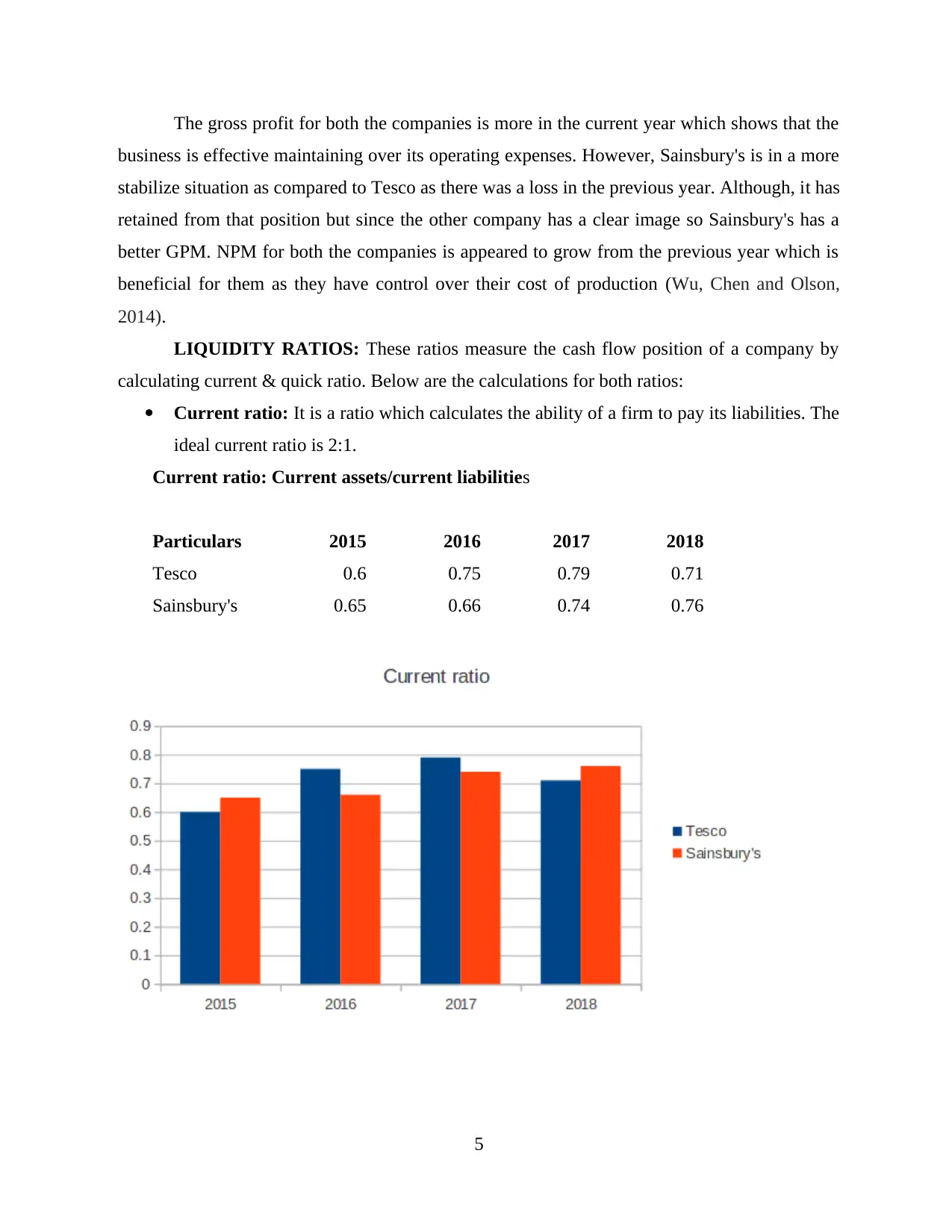
The gross profit for both the companies is more in the current year which shows that the
business is effective maintaining over its operating expenses. However, Sainsbury's is in a more
stabilize situation as compared to Tesco as there was a loss in the previous year. Although, it has
retained from that position but since the other company has a clear image so Sainsbury's has a
better GPM. NPM for both the companies is appeared to grow from the previous year which is
beneficial for them as they have control over their cost of production (Wu, Chen and Olson,
2014).
LIQUIDITY RATIOS: These ratios measure the cash flow position of a company by
calculating current & quick ratio. Below are the calculations for both ratios:
Current ratio: It is a ratio which calculates the ability of a firm to pay its liabilities. The
ideal current ratio is 2:1.
Current ratio: Current assets/current liabilities
Particulars 2015 2016 2017 2018
Tesco 0.6 0.75 0.79 0.71
Sainsbury's 0.65 0.66 0.74 0.76
5
business is effective maintaining over its operating expenses. However, Sainsbury's is in a more
stabilize situation as compared to Tesco as there was a loss in the previous year. Although, it has
retained from that position but since the other company has a clear image so Sainsbury's has a
better GPM. NPM for both the companies is appeared to grow from the previous year which is
beneficial for them as they have control over their cost of production (Wu, Chen and Olson,
2014).
LIQUIDITY RATIOS: These ratios measure the cash flow position of a company by
calculating current & quick ratio. Below are the calculations for both ratios:
Current ratio: It is a ratio which calculates the ability of a firm to pay its liabilities. The
ideal current ratio is 2:1.
Current ratio: Current assets/current liabilities
Particulars 2015 2016 2017 2018
Tesco 0.6 0.75 0.79 0.71
Sainsbury's 0.65 0.66 0.74 0.76
5
Paraphrase This Document
Need a fresh take? Get an instant paraphrase of this document with our AI Paraphraser
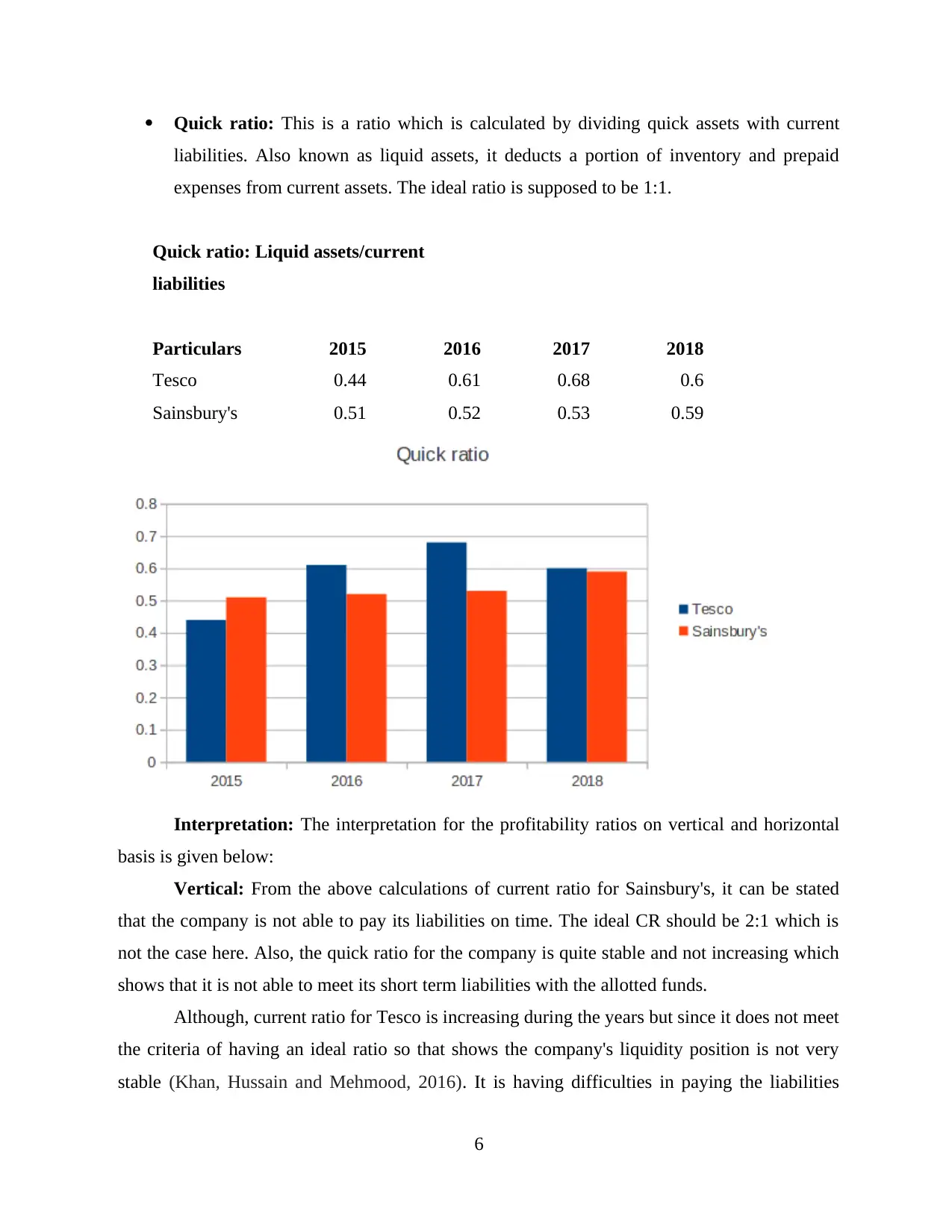
Quick ratio: This is a ratio which is calculated by dividing quick assets with current
liabilities. Also known as liquid assets, it deducts a portion of inventory and prepaid
expenses from current assets. The ideal ratio is supposed to be 1:1.
Quick ratio: Liquid assets/current
liabilities
Particulars 2015 2016 2017 2018
Tesco 0.44 0.61 0.68 0.6
Sainsbury's 0.51 0.52 0.53 0.59
Interpretation: The interpretation for the profitability ratios on vertical and horizontal
basis is given below:
Vertical: From the above calculations of current ratio for Sainsbury's, it can be stated
that the company is not able to pay its liabilities on time. The ideal CR should be 2:1 which is
not the case here. Also, the quick ratio for the company is quite stable and not increasing which
shows that it is not able to meet its short term liabilities with the allotted funds.
Although, current ratio for Tesco is increasing during the years but since it does not meet
the criteria of having an ideal ratio so that shows the company's liquidity position is not very
stable (Khan, Hussain and Mehmood, 2016). It is having difficulties in paying the liabilities
6
liabilities. Also known as liquid assets, it deducts a portion of inventory and prepaid
expenses from current assets. The ideal ratio is supposed to be 1:1.
Quick ratio: Liquid assets/current
liabilities
Particulars 2015 2016 2017 2018
Tesco 0.44 0.61 0.68 0.6
Sainsbury's 0.51 0.52 0.53 0.59
Interpretation: The interpretation for the profitability ratios on vertical and horizontal
basis is given below:
Vertical: From the above calculations of current ratio for Sainsbury's, it can be stated
that the company is not able to pay its liabilities on time. The ideal CR should be 2:1 which is
not the case here. Also, the quick ratio for the company is quite stable and not increasing which
shows that it is not able to meet its short term liabilities with the allotted funds.
Although, current ratio for Tesco is increasing during the years but since it does not meet
the criteria of having an ideal ratio so that shows the company's liquidity position is not very
stable (Khan, Hussain and Mehmood, 2016). It is having difficulties in paying the liabilities
6
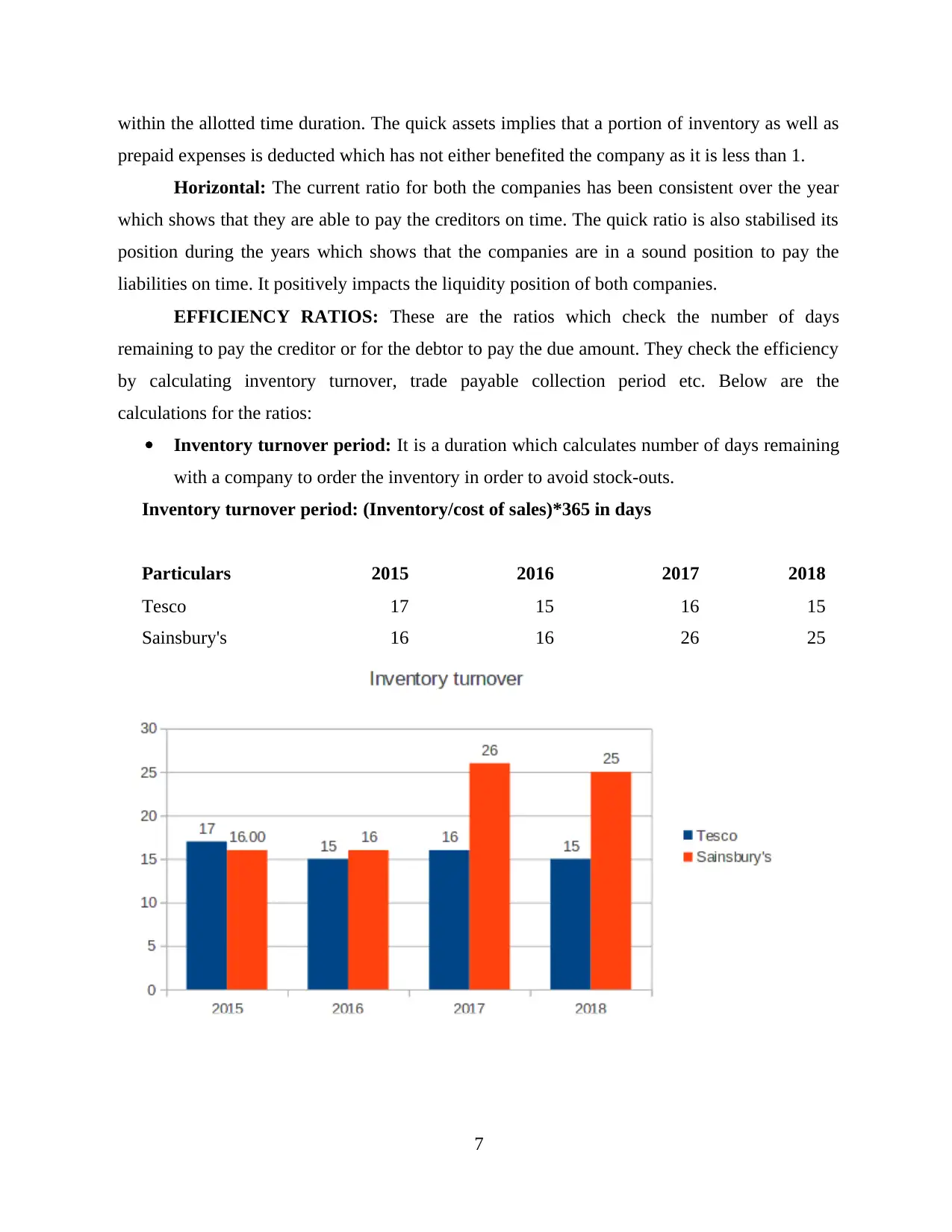
within the allotted time duration. The quick assets implies that a portion of inventory as well as
prepaid expenses is deducted which has not either benefited the company as it is less than 1.
Horizontal: The current ratio for both the companies has been consistent over the year
which shows that they are able to pay the creditors on time. The quick ratio is also stabilised its
position during the years which shows that the companies are in a sound position to pay the
liabilities on time. It positively impacts the liquidity position of both companies.
EFFICIENCY RATIOS: These are the ratios which check the number of days
remaining to pay the creditor or for the debtor to pay the due amount. They check the efficiency
by calculating inventory turnover, trade payable collection period etc. Below are the
calculations for the ratios:
Inventory turnover period: It is a duration which calculates number of days remaining
with a company to order the inventory in order to avoid stock-outs.
Inventory turnover period: (Inventory/cost of sales)*365 in days
Particulars 2015 2016 2017 2018
Tesco 17 15 16 15
Sainsbury's 16 16 26 25
7
prepaid expenses is deducted which has not either benefited the company as it is less than 1.
Horizontal: The current ratio for both the companies has been consistent over the year
which shows that they are able to pay the creditors on time. The quick ratio is also stabilised its
position during the years which shows that the companies are in a sound position to pay the
liabilities on time. It positively impacts the liquidity position of both companies.
EFFICIENCY RATIOS: These are the ratios which check the number of days
remaining to pay the creditor or for the debtor to pay the due amount. They check the efficiency
by calculating inventory turnover, trade payable collection period etc. Below are the
calculations for the ratios:
Inventory turnover period: It is a duration which calculates number of days remaining
with a company to order the inventory in order to avoid stock-outs.
Inventory turnover period: (Inventory/cost of sales)*365 in days
Particulars 2015 2016 2017 2018
Tesco 17 15 16 15
Sainsbury's 16 16 26 25
7
You're viewing a preview
Unlock full access by subscribing today!
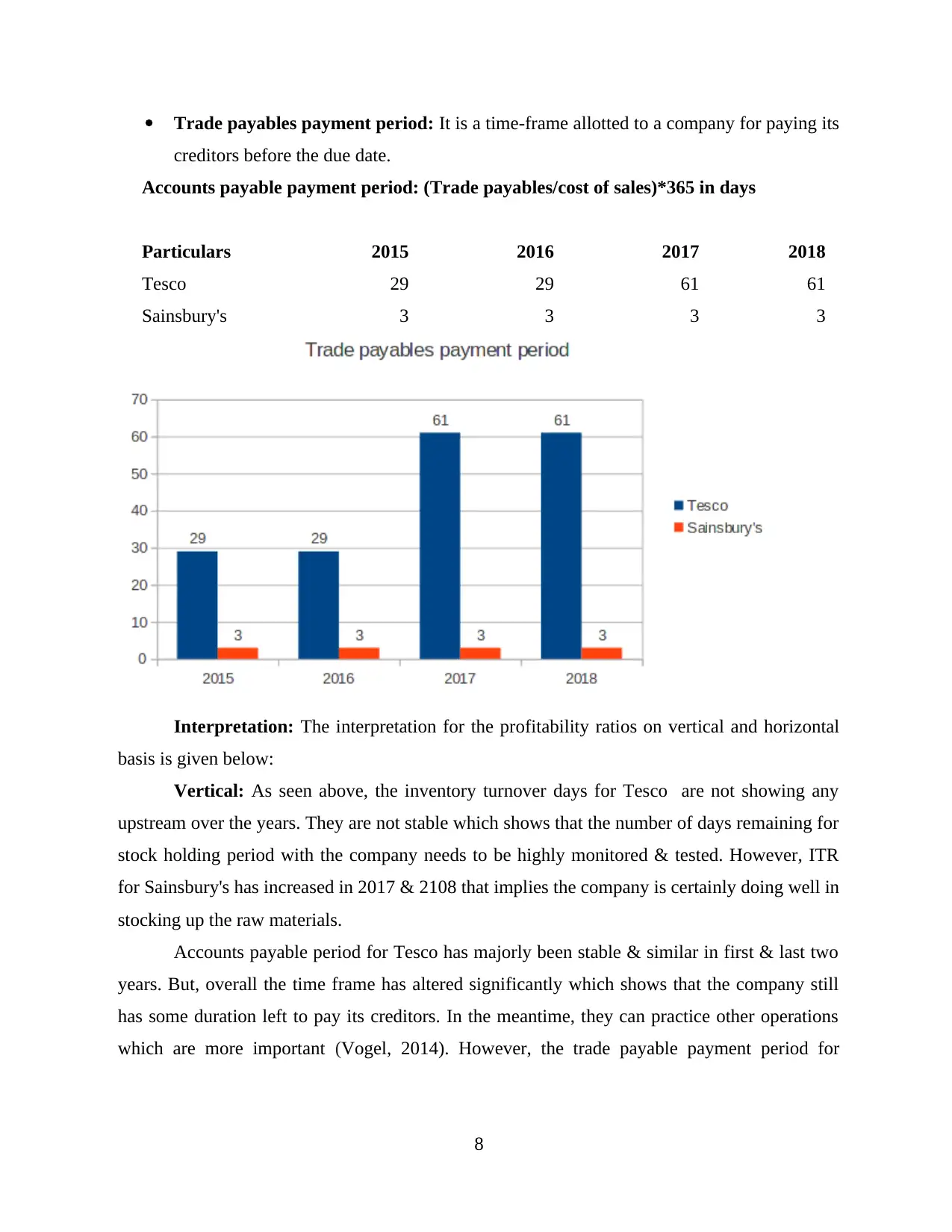
Trade payables payment period: It is a time-frame allotted to a company for paying its
creditors before the due date.
Accounts payable payment period: (Trade payables/cost of sales)*365 in days
Particulars 2015 2016 2017 2018
Tesco 29 29 61 61
Sainsbury's 3 3 3 3
Interpretation: The interpretation for the profitability ratios on vertical and horizontal
basis is given below:
Vertical: As seen above, the inventory turnover days for Tesco are not showing any
upstream over the years. They are not stable which shows that the number of days remaining for
stock holding period with the company needs to be highly monitored & tested. However, ITR
for Sainsbury's has increased in 2017 & 2108 that implies the company is certainly doing well in
stocking up the raw materials.
Accounts payable period for Tesco has majorly been stable & similar in first & last two
years. But, overall the time frame has altered significantly which shows that the company still
has some duration left to pay its creditors. In the meantime, they can practice other operations
which are more important (Vogel, 2014). However, the trade payable payment period for
8
creditors before the due date.
Accounts payable payment period: (Trade payables/cost of sales)*365 in days
Particulars 2015 2016 2017 2018
Tesco 29 29 61 61
Sainsbury's 3 3 3 3
Interpretation: The interpretation for the profitability ratios on vertical and horizontal
basis is given below:
Vertical: As seen above, the inventory turnover days for Tesco are not showing any
upstream over the years. They are not stable which shows that the number of days remaining for
stock holding period with the company needs to be highly monitored & tested. However, ITR
for Sainsbury's has increased in 2017 & 2108 that implies the company is certainly doing well in
stocking up the raw materials.
Accounts payable period for Tesco has majorly been stable & similar in first & last two
years. But, overall the time frame has altered significantly which shows that the company still
has some duration left to pay its creditors. In the meantime, they can practice other operations
which are more important (Vogel, 2014). However, the trade payable payment period for
8
Paraphrase This Document
Need a fresh take? Get an instant paraphrase of this document with our AI Paraphraser
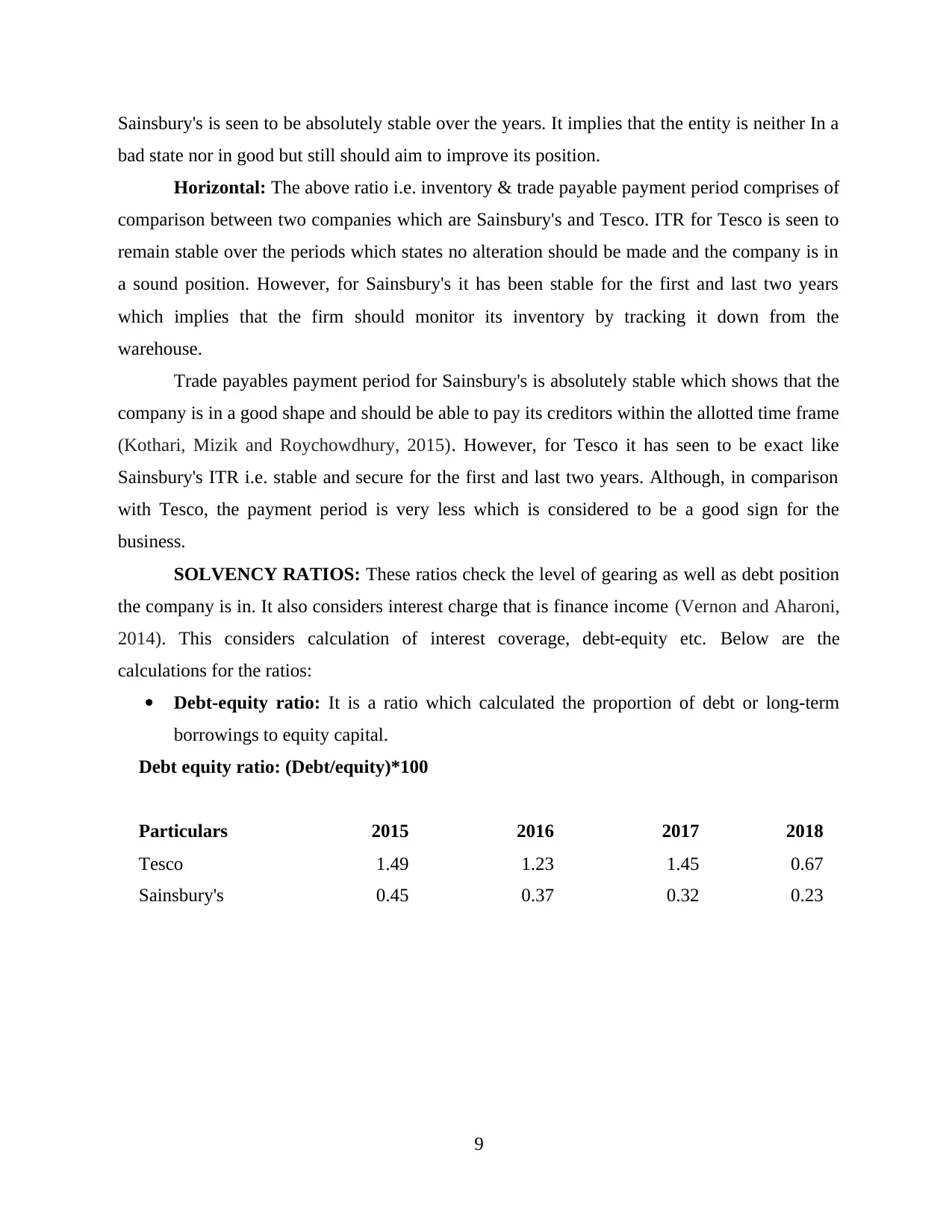
Sainsbury's is seen to be absolutely stable over the years. It implies that the entity is neither In a
bad state nor in good but still should aim to improve its position.
Horizontal: The above ratio i.e. inventory & trade payable payment period comprises of
comparison between two companies which are Sainsbury's and Tesco. ITR for Tesco is seen to
remain stable over the periods which states no alteration should be made and the company is in
a sound position. However, for Sainsbury's it has been stable for the first and last two years
which implies that the firm should monitor its inventory by tracking it down from the
warehouse.
Trade payables payment period for Sainsbury's is absolutely stable which shows that the
company is in a good shape and should be able to pay its creditors within the allotted time frame
(Kothari, Mizik and Roychowdhury, 2015). However, for Tesco it has seen to be exact like
Sainsbury's ITR i.e. stable and secure for the first and last two years. Although, in comparison
with Tesco, the payment period is very less which is considered to be a good sign for the
business.
SOLVENCY RATIOS: These ratios check the level of gearing as well as debt position
the company is in. It also considers interest charge that is finance income (Vernon and Aharoni,
2014). This considers calculation of interest coverage, debt-equity etc. Below are the
calculations for the ratios:
Debt-equity ratio: It is a ratio which calculated the proportion of debt or long-term
borrowings to equity capital.
Debt equity ratio: (Debt/equity)*100
Particulars 2015 2016 2017 2018
Tesco 1.49 1.23 1.45 0.67
Sainsbury's 0.45 0.37 0.32 0.23
9
bad state nor in good but still should aim to improve its position.
Horizontal: The above ratio i.e. inventory & trade payable payment period comprises of
comparison between two companies which are Sainsbury's and Tesco. ITR for Tesco is seen to
remain stable over the periods which states no alteration should be made and the company is in
a sound position. However, for Sainsbury's it has been stable for the first and last two years
which implies that the firm should monitor its inventory by tracking it down from the
warehouse.
Trade payables payment period for Sainsbury's is absolutely stable which shows that the
company is in a good shape and should be able to pay its creditors within the allotted time frame
(Kothari, Mizik and Roychowdhury, 2015). However, for Tesco it has seen to be exact like
Sainsbury's ITR i.e. stable and secure for the first and last two years. Although, in comparison
with Tesco, the payment period is very less which is considered to be a good sign for the
business.
SOLVENCY RATIOS: These ratios check the level of gearing as well as debt position
the company is in. It also considers interest charge that is finance income (Vernon and Aharoni,
2014). This considers calculation of interest coverage, debt-equity etc. Below are the
calculations for the ratios:
Debt-equity ratio: It is a ratio which calculated the proportion of debt or long-term
borrowings to equity capital.
Debt equity ratio: (Debt/equity)*100
Particulars 2015 2016 2017 2018
Tesco 1.49 1.23 1.45 0.67
Sainsbury's 0.45 0.37 0.32 0.23
9
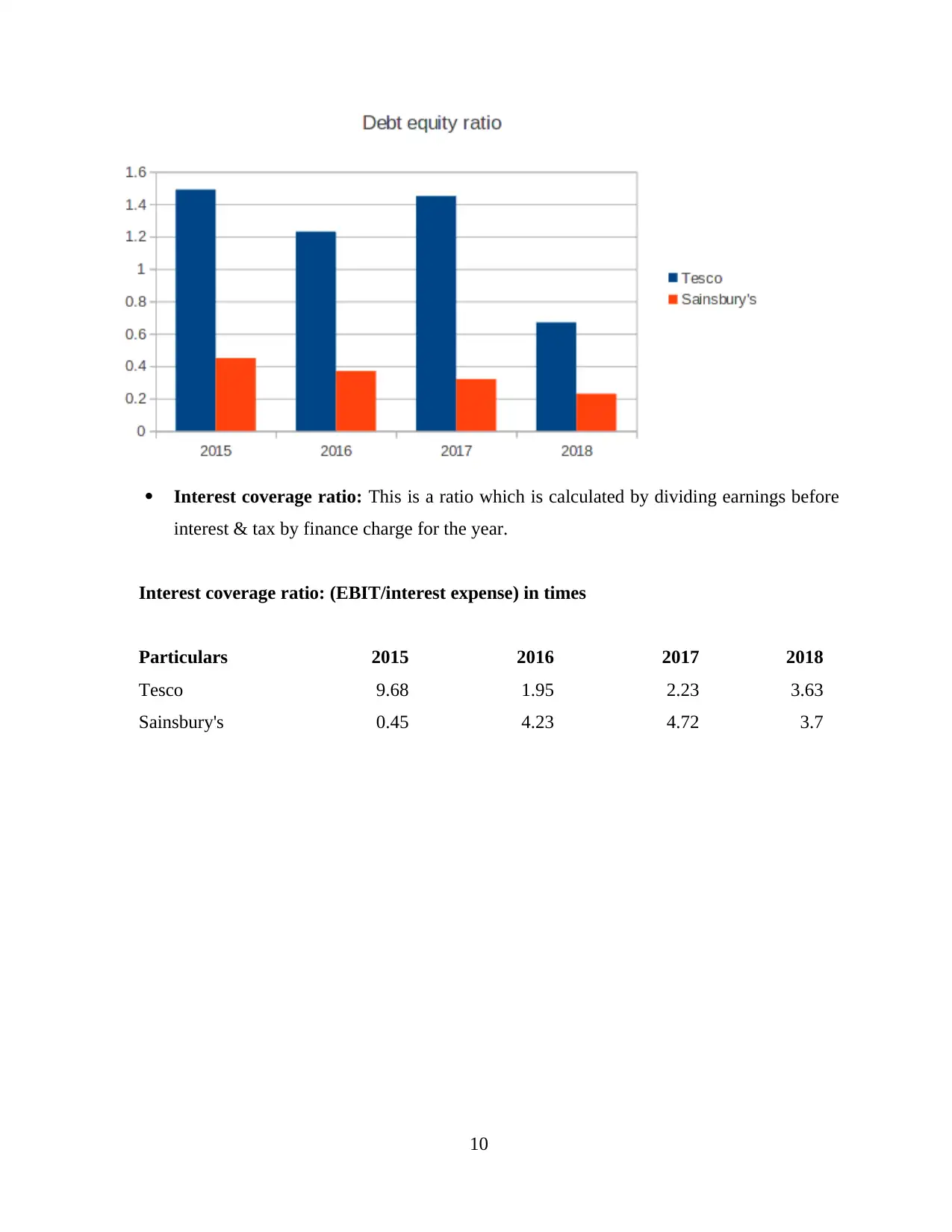
Interest coverage ratio: This is a ratio which is calculated by dividing earnings before
interest & tax by finance charge for the year.
Interest coverage ratio: (EBIT/interest expense) in times
Particulars 2015 2016 2017 2018
Tesco 9.68 1.95 2.23 3.63
Sainsbury's 0.45 4.23 4.72 3.7
10
interest & tax by finance charge for the year.
Interest coverage ratio: (EBIT/interest expense) in times
Particulars 2015 2016 2017 2018
Tesco 9.68 1.95 2.23 3.63
Sainsbury's 0.45 4.23 4.72 3.7
10
You're viewing a preview
Unlock full access by subscribing today!
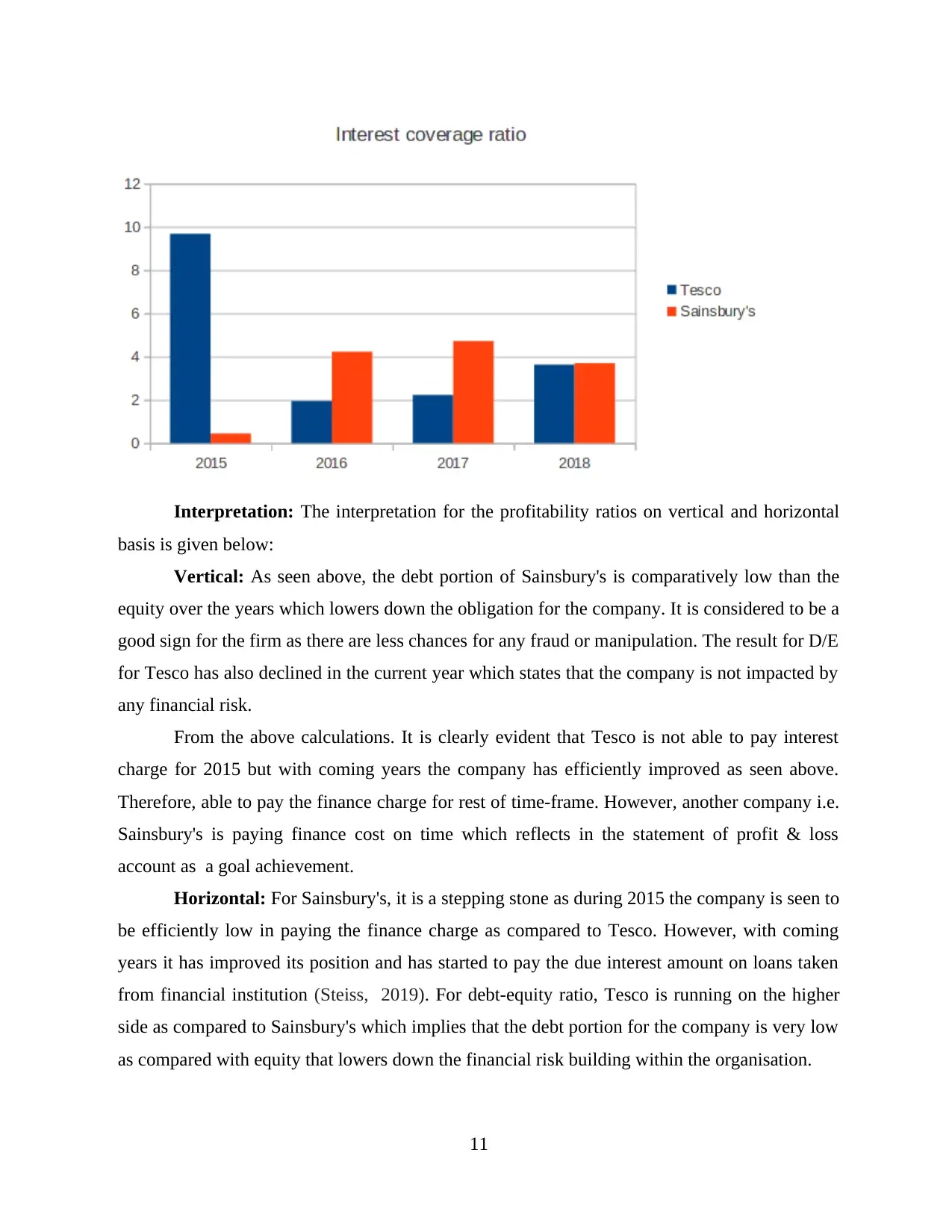
Interpretation: The interpretation for the profitability ratios on vertical and horizontal
basis is given below:
Vertical: As seen above, the debt portion of Sainsbury's is comparatively low than the
equity over the years which lowers down the obligation for the company. It is considered to be a
good sign for the firm as there are less chances for any fraud or manipulation. The result for D/E
for Tesco has also declined in the current year which states that the company is not impacted by
any financial risk.
From the above calculations. It is clearly evident that Tesco is not able to pay interest
charge for 2015 but with coming years the company has efficiently improved as seen above.
Therefore, able to pay the finance charge for rest of time-frame. However, another company i.e.
Sainsbury's is paying finance cost on time which reflects in the statement of profit & loss
account as a goal achievement.
Horizontal: For Sainsbury's, it is a stepping stone as during 2015 the company is seen to
be efficiently low in paying the finance charge as compared to Tesco. However, with coming
years it has improved its position and has started to pay the due interest amount on loans taken
from financial institution (Steiss, 2019). For debt-equity ratio, Tesco is running on the higher
side as compared to Sainsbury's which implies that the debt portion for the company is very low
as compared with equity that lowers down the financial risk building within the organisation.
11
basis is given below:
Vertical: As seen above, the debt portion of Sainsbury's is comparatively low than the
equity over the years which lowers down the obligation for the company. It is considered to be a
good sign for the firm as there are less chances for any fraud or manipulation. The result for D/E
for Tesco has also declined in the current year which states that the company is not impacted by
any financial risk.
From the above calculations. It is clearly evident that Tesco is not able to pay interest
charge for 2015 but with coming years the company has efficiently improved as seen above.
Therefore, able to pay the finance charge for rest of time-frame. However, another company i.e.
Sainsbury's is paying finance cost on time which reflects in the statement of profit & loss
account as a goal achievement.
Horizontal: For Sainsbury's, it is a stepping stone as during 2015 the company is seen to
be efficiently low in paying the finance charge as compared to Tesco. However, with coming
years it has improved its position and has started to pay the due interest amount on loans taken
from financial institution (Steiss, 2019). For debt-equity ratio, Tesco is running on the higher
side as compared to Sainsbury's which implies that the debt portion for the company is very low
as compared with equity that lowers down the financial risk building within the organisation.
11
Paraphrase This Document
Need a fresh take? Get an instant paraphrase of this document with our AI Paraphraser
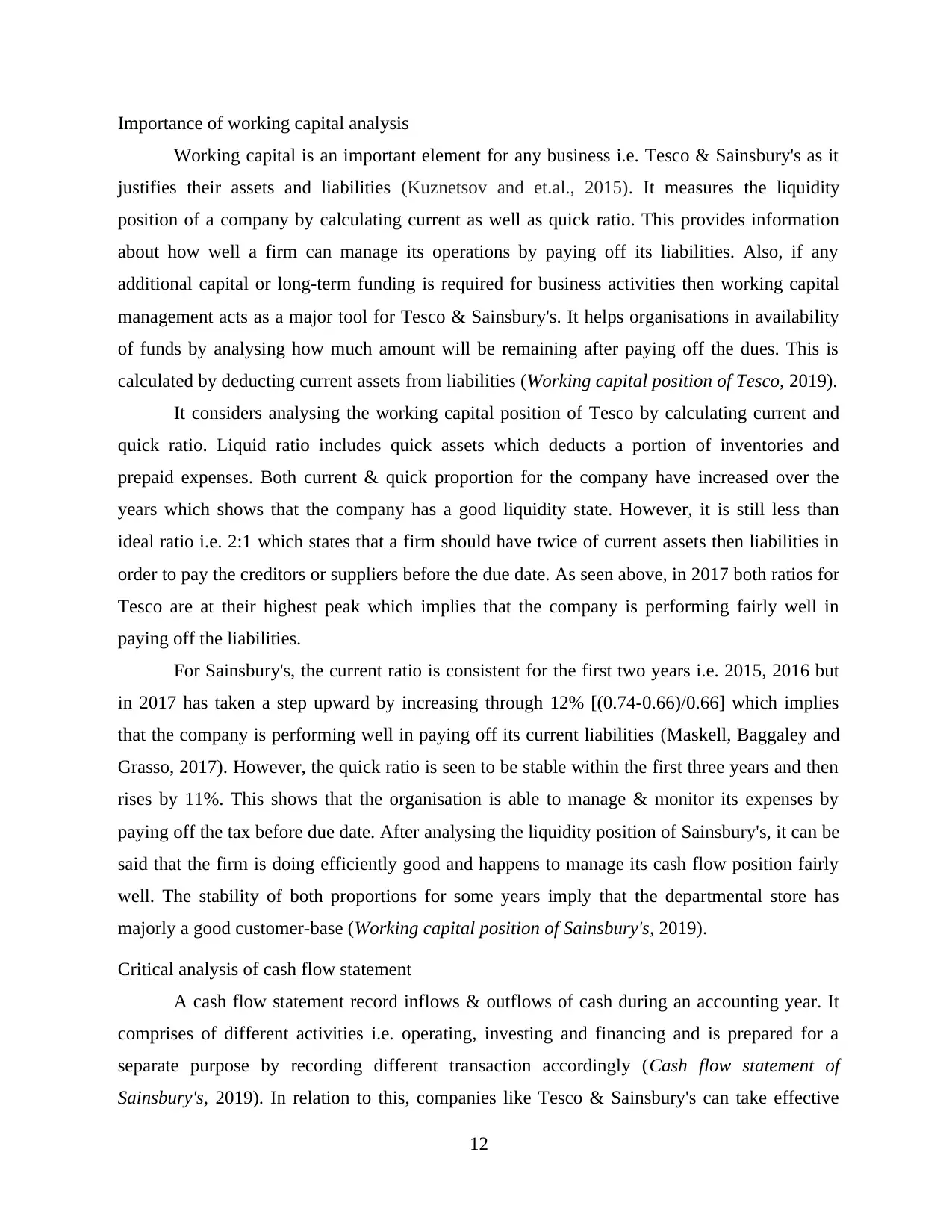
Importance of working capital analysis
Working capital is an important element for any business i.e. Tesco & Sainsbury's as it
justifies their assets and liabilities (Kuznetsov and et.al., 2015). It measures the liquidity
position of a company by calculating current as well as quick ratio. This provides information
about how well a firm can manage its operations by paying off its liabilities. Also, if any
additional capital or long-term funding is required for business activities then working capital
management acts as a major tool for Tesco & Sainsbury's. It helps organisations in availability
of funds by analysing how much amount will be remaining after paying off the dues. This is
calculated by deducting current assets from liabilities (Working capital position of Tesco, 2019).
It considers analysing the working capital position of Tesco by calculating current and
quick ratio. Liquid ratio includes quick assets which deducts a portion of inventories and
prepaid expenses. Both current & quick proportion for the company have increased over the
years which shows that the company has a good liquidity state. However, it is still less than
ideal ratio i.e. 2:1 which states that a firm should have twice of current assets then liabilities in
order to pay the creditors or suppliers before the due date. As seen above, in 2017 both ratios for
Tesco are at their highest peak which implies that the company is performing fairly well in
paying off the liabilities.
For Sainsbury's, the current ratio is consistent for the first two years i.e. 2015, 2016 but
in 2017 has taken a step upward by increasing through 12% [(0.74-0.66)/0.66] which implies
that the company is performing well in paying off its current liabilities (Maskell, Baggaley and
Grasso, 2017). However, the quick ratio is seen to be stable within the first three years and then
rises by 11%. This shows that the organisation is able to manage & monitor its expenses by
paying off the tax before due date. After analysing the liquidity position of Sainsbury's, it can be
said that the firm is doing efficiently good and happens to manage its cash flow position fairly
well. The stability of both proportions for some years imply that the departmental store has
majorly a good customer-base (Working capital position of Sainsbury's, 2019).
Critical analysis of cash flow statement
A cash flow statement record inflows & outflows of cash during an accounting year. It
comprises of different activities i.e. operating, investing and financing and is prepared for a
separate purpose by recording different transaction accordingly (Cash flow statement of
Sainsbury's, 2019). In relation to this, companies like Tesco & Sainsbury's can take effective
12
Working capital is an important element for any business i.e. Tesco & Sainsbury's as it
justifies their assets and liabilities (Kuznetsov and et.al., 2015). It measures the liquidity
position of a company by calculating current as well as quick ratio. This provides information
about how well a firm can manage its operations by paying off its liabilities. Also, if any
additional capital or long-term funding is required for business activities then working capital
management acts as a major tool for Tesco & Sainsbury's. It helps organisations in availability
of funds by analysing how much amount will be remaining after paying off the dues. This is
calculated by deducting current assets from liabilities (Working capital position of Tesco, 2019).
It considers analysing the working capital position of Tesco by calculating current and
quick ratio. Liquid ratio includes quick assets which deducts a portion of inventories and
prepaid expenses. Both current & quick proportion for the company have increased over the
years which shows that the company has a good liquidity state. However, it is still less than
ideal ratio i.e. 2:1 which states that a firm should have twice of current assets then liabilities in
order to pay the creditors or suppliers before the due date. As seen above, in 2017 both ratios for
Tesco are at their highest peak which implies that the company is performing fairly well in
paying off the liabilities.
For Sainsbury's, the current ratio is consistent for the first two years i.e. 2015, 2016 but
in 2017 has taken a step upward by increasing through 12% [(0.74-0.66)/0.66] which implies
that the company is performing well in paying off its current liabilities (Maskell, Baggaley and
Grasso, 2017). However, the quick ratio is seen to be stable within the first three years and then
rises by 11%. This shows that the organisation is able to manage & monitor its expenses by
paying off the tax before due date. After analysing the liquidity position of Sainsbury's, it can be
said that the firm is doing efficiently good and happens to manage its cash flow position fairly
well. The stability of both proportions for some years imply that the departmental store has
majorly a good customer-base (Working capital position of Sainsbury's, 2019).
Critical analysis of cash flow statement
A cash flow statement record inflows & outflows of cash during an accounting year. It
comprises of different activities i.e. operating, investing and financing and is prepared for a
separate purpose by recording different transaction accordingly (Cash flow statement of
Sainsbury's, 2019). In relation to this, companies like Tesco & Sainsbury's can take effective
12
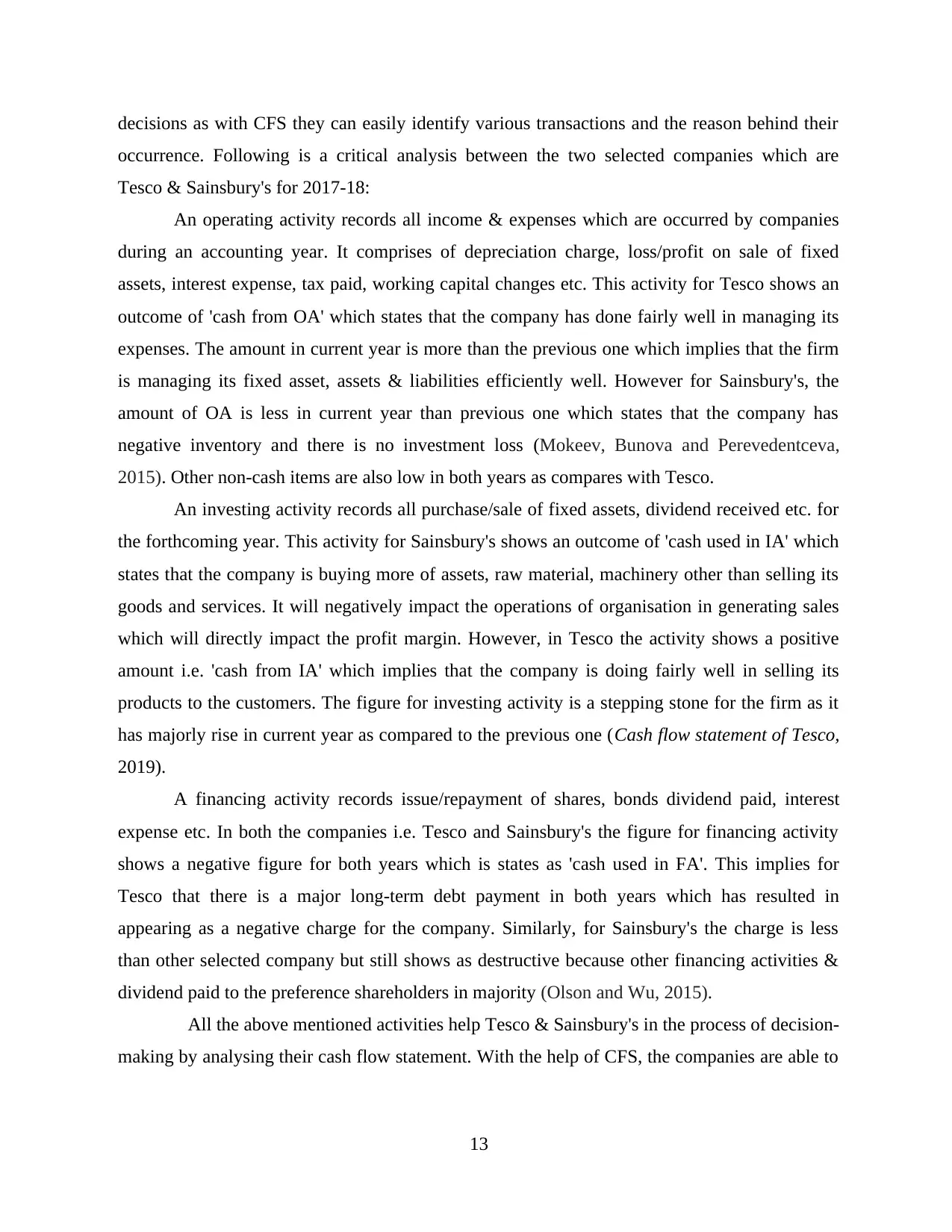
decisions as with CFS they can easily identify various transactions and the reason behind their
occurrence. Following is a critical analysis between the two selected companies which are
Tesco & Sainsbury's for 2017-18:
An operating activity records all income & expenses which are occurred by companies
during an accounting year. It comprises of depreciation charge, loss/profit on sale of fixed
assets, interest expense, tax paid, working capital changes etc. This activity for Tesco shows an
outcome of 'cash from OA' which states that the company has done fairly well in managing its
expenses. The amount in current year is more than the previous one which implies that the firm
is managing its fixed asset, assets & liabilities efficiently well. However for Sainsbury's, the
amount of OA is less in current year than previous one which states that the company has
negative inventory and there is no investment loss (Mokeev, Bunova and Perevedentceva,
2015). Other non-cash items are also low in both years as compares with Tesco.
An investing activity records all purchase/sale of fixed assets, dividend received etc. for
the forthcoming year. This activity for Sainsbury's shows an outcome of 'cash used in IA' which
states that the company is buying more of assets, raw material, machinery other than selling its
goods and services. It will negatively impact the operations of organisation in generating sales
which will directly impact the profit margin. However, in Tesco the activity shows a positive
amount i.e. 'cash from IA' which implies that the company is doing fairly well in selling its
products to the customers. The figure for investing activity is a stepping stone for the firm as it
has majorly rise in current year as compared to the previous one (Cash flow statement of Tesco,
2019).
A financing activity records issue/repayment of shares, bonds dividend paid, interest
expense etc. In both the companies i.e. Tesco and Sainsbury's the figure for financing activity
shows a negative figure for both years which is states as 'cash used in FA'. This implies for
Tesco that there is a major long-term debt payment in both years which has resulted in
appearing as a negative charge for the company. Similarly, for Sainsbury's the charge is less
than other selected company but still shows as destructive because other financing activities &
dividend paid to the preference shareholders in majority (Olson and Wu, 2015).
All the above mentioned activities help Tesco & Sainsbury's in the process of decision-
making by analysing their cash flow statement. With the help of CFS, the companies are able to
13
occurrence. Following is a critical analysis between the two selected companies which are
Tesco & Sainsbury's for 2017-18:
An operating activity records all income & expenses which are occurred by companies
during an accounting year. It comprises of depreciation charge, loss/profit on sale of fixed
assets, interest expense, tax paid, working capital changes etc. This activity for Tesco shows an
outcome of 'cash from OA' which states that the company has done fairly well in managing its
expenses. The amount in current year is more than the previous one which implies that the firm
is managing its fixed asset, assets & liabilities efficiently well. However for Sainsbury's, the
amount of OA is less in current year than previous one which states that the company has
negative inventory and there is no investment loss (Mokeev, Bunova and Perevedentceva,
2015). Other non-cash items are also low in both years as compares with Tesco.
An investing activity records all purchase/sale of fixed assets, dividend received etc. for
the forthcoming year. This activity for Sainsbury's shows an outcome of 'cash used in IA' which
states that the company is buying more of assets, raw material, machinery other than selling its
goods and services. It will negatively impact the operations of organisation in generating sales
which will directly impact the profit margin. However, in Tesco the activity shows a positive
amount i.e. 'cash from IA' which implies that the company is doing fairly well in selling its
products to the customers. The figure for investing activity is a stepping stone for the firm as it
has majorly rise in current year as compared to the previous one (Cash flow statement of Tesco,
2019).
A financing activity records issue/repayment of shares, bonds dividend paid, interest
expense etc. In both the companies i.e. Tesco and Sainsbury's the figure for financing activity
shows a negative figure for both years which is states as 'cash used in FA'. This implies for
Tesco that there is a major long-term debt payment in both years which has resulted in
appearing as a negative charge for the company. Similarly, for Sainsbury's the charge is less
than other selected company but still shows as destructive because other financing activities &
dividend paid to the preference shareholders in majority (Olson and Wu, 2015).
All the above mentioned activities help Tesco & Sainsbury's in the process of decision-
making by analysing their cash flow statement. With the help of CFS, the companies are able to
13
You're viewing a preview
Unlock full access by subscribing today!
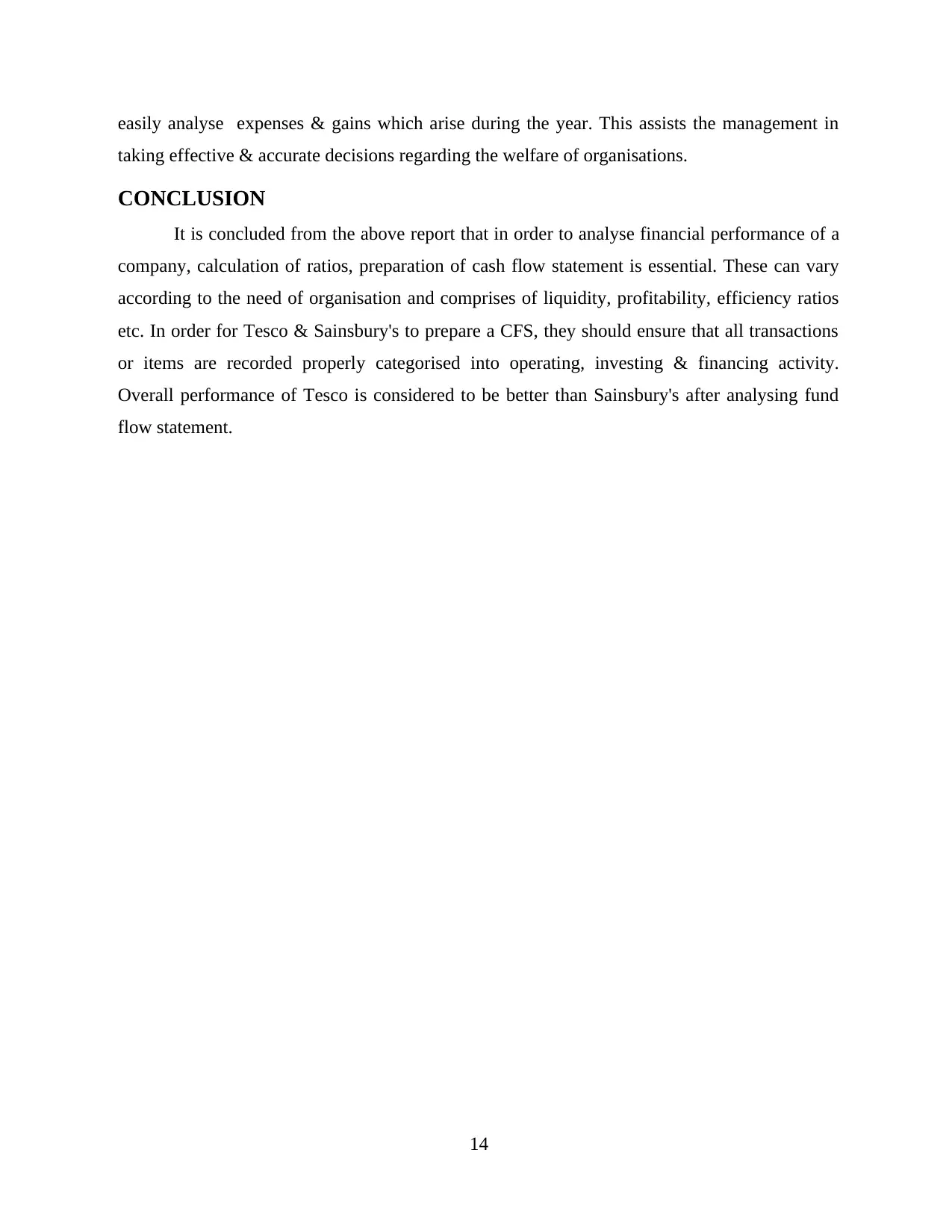
easily analyse expenses & gains which arise during the year. This assists the management in
taking effective & accurate decisions regarding the welfare of organisations.
CONCLUSION
It is concluded from the above report that in order to analyse financial performance of a
company, calculation of ratios, preparation of cash flow statement is essential. These can vary
according to the need of organisation and comprises of liquidity, profitability, efficiency ratios
etc. In order for Tesco & Sainsbury's to prepare a CFS, they should ensure that all transactions
or items are recorded properly categorised into operating, investing & financing activity.
Overall performance of Tesco is considered to be better than Sainsbury's after analysing fund
flow statement.
14
taking effective & accurate decisions regarding the welfare of organisations.
CONCLUSION
It is concluded from the above report that in order to analyse financial performance of a
company, calculation of ratios, preparation of cash flow statement is essential. These can vary
according to the need of organisation and comprises of liquidity, profitability, efficiency ratios
etc. In order for Tesco & Sainsbury's to prepare a CFS, they should ensure that all transactions
or items are recorded properly categorised into operating, investing & financing activity.
Overall performance of Tesco is considered to be better than Sainsbury's after analysing fund
flow statement.
14
Paraphrase This Document
Need a fresh take? Get an instant paraphrase of this document with our AI Paraphraser
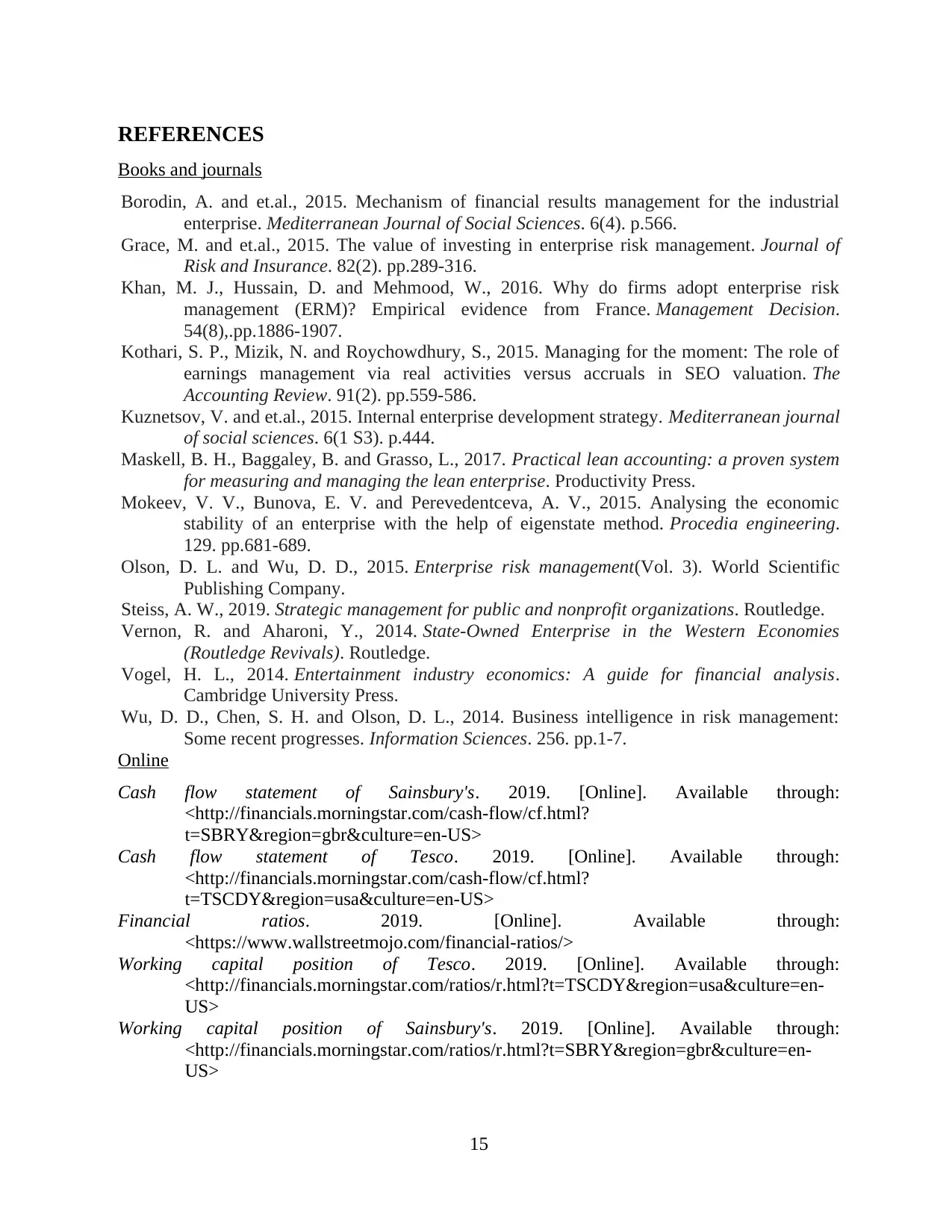
REFERENCES
Books and journals
Borodin, A. and et.al., 2015. Mechanism of financial results management for the industrial
enterprise. Mediterranean Journal of Social Sciences. 6(4). p.566.
Grace, M. and et.al., 2015. The value of investing in enterprise risk management. Journal of
Risk and Insurance. 82(2). pp.289-316.
Khan, M. J., Hussain, D. and Mehmood, W., 2016. Why do firms adopt enterprise risk
management (ERM)? Empirical evidence from France. Management Decision.
54(8),.pp.1886-1907.
Kothari, S. P., Mizik, N. and Roychowdhury, S., 2015. Managing for the moment: The role of
earnings management via real activities versus accruals in SEO valuation. The
Accounting Review. 91(2). pp.559-586.
Kuznetsov, V. and et.al., 2015. Internal enterprise development strategy. Mediterranean journal
of social sciences. 6(1 S3). p.444.
Maskell, B. H., Baggaley, B. and Grasso, L., 2017. Practical lean accounting: a proven system
for measuring and managing the lean enterprise. Productivity Press.
Mokeev, V. V., Bunova, E. V. and Perevedentceva, A. V., 2015. Analysing the economic
stability of an enterprise with the help of eigenstate method. Procedia engineering.
129. pp.681-689.
Olson, D. L. and Wu, D. D., 2015. Enterprise risk management(Vol. 3). World Scientific
Publishing Company.
Steiss, A. W., 2019. Strategic management for public and nonprofit organizations. Routledge.
Vernon, R. and Aharoni, Y., 2014. State-Owned Enterprise in the Western Economies
(Routledge Revivals). Routledge.
Vogel, H. L., 2014. Entertainment industry economics: A guide for financial analysis.
Cambridge University Press.
Wu, D. D., Chen, S. H. and Olson, D. L., 2014. Business intelligence in risk management:
Some recent progresses. Information Sciences. 256. pp.1-7.
Online
Cash flow statement of Sainsbury's. 2019. [Online]. Available through:
<http://financials.morningstar.com/cash-flow/cf.html?
t=SBRY®ion=gbr&culture=en-US>
Cash flow statement of Tesco. 2019. [Online]. Available through:
<http://financials.morningstar.com/cash-flow/cf.html?
t=TSCDY®ion=usa&culture=en-US>
Financial ratios. 2019. [Online]. Available through:
<https://www.wallstreetmojo.com/financial-ratios/>
Working capital position of Tesco. 2019. [Online]. Available through:
<http://financials.morningstar.com/ratios/r.html?t=TSCDY®ion=usa&culture=en-
US>
Working capital position of Sainsbury's. 2019. [Online]. Available through:
<http://financials.morningstar.com/ratios/r.html?t=SBRY®ion=gbr&culture=en-
US>
15
Books and journals
Borodin, A. and et.al., 2015. Mechanism of financial results management for the industrial
enterprise. Mediterranean Journal of Social Sciences. 6(4). p.566.
Grace, M. and et.al., 2015. The value of investing in enterprise risk management. Journal of
Risk and Insurance. 82(2). pp.289-316.
Khan, M. J., Hussain, D. and Mehmood, W., 2016. Why do firms adopt enterprise risk
management (ERM)? Empirical evidence from France. Management Decision.
54(8),.pp.1886-1907.
Kothari, S. P., Mizik, N. and Roychowdhury, S., 2015. Managing for the moment: The role of
earnings management via real activities versus accruals in SEO valuation. The
Accounting Review. 91(2). pp.559-586.
Kuznetsov, V. and et.al., 2015. Internal enterprise development strategy. Mediterranean journal
of social sciences. 6(1 S3). p.444.
Maskell, B. H., Baggaley, B. and Grasso, L., 2017. Practical lean accounting: a proven system
for measuring and managing the lean enterprise. Productivity Press.
Mokeev, V. V., Bunova, E. V. and Perevedentceva, A. V., 2015. Analysing the economic
stability of an enterprise with the help of eigenstate method. Procedia engineering.
129. pp.681-689.
Olson, D. L. and Wu, D. D., 2015. Enterprise risk management(Vol. 3). World Scientific
Publishing Company.
Steiss, A. W., 2019. Strategic management for public and nonprofit organizations. Routledge.
Vernon, R. and Aharoni, Y., 2014. State-Owned Enterprise in the Western Economies
(Routledge Revivals). Routledge.
Vogel, H. L., 2014. Entertainment industry economics: A guide for financial analysis.
Cambridge University Press.
Wu, D. D., Chen, S. H. and Olson, D. L., 2014. Business intelligence in risk management:
Some recent progresses. Information Sciences. 256. pp.1-7.
Online
Cash flow statement of Sainsbury's. 2019. [Online]. Available through:
<http://financials.morningstar.com/cash-flow/cf.html?
t=SBRY®ion=gbr&culture=en-US>
Cash flow statement of Tesco. 2019. [Online]. Available through:
<http://financials.morningstar.com/cash-flow/cf.html?
t=TSCDY®ion=usa&culture=en-US>
Financial ratios. 2019. [Online]. Available through:
<https://www.wallstreetmojo.com/financial-ratios/>
Working capital position of Tesco. 2019. [Online]. Available through:
<http://financials.morningstar.com/ratios/r.html?t=TSCDY®ion=usa&culture=en-
US>
Working capital position of Sainsbury's. 2019. [Online]. Available through:
<http://financials.morningstar.com/ratios/r.html?t=SBRY®ion=gbr&culture=en-
US>
15
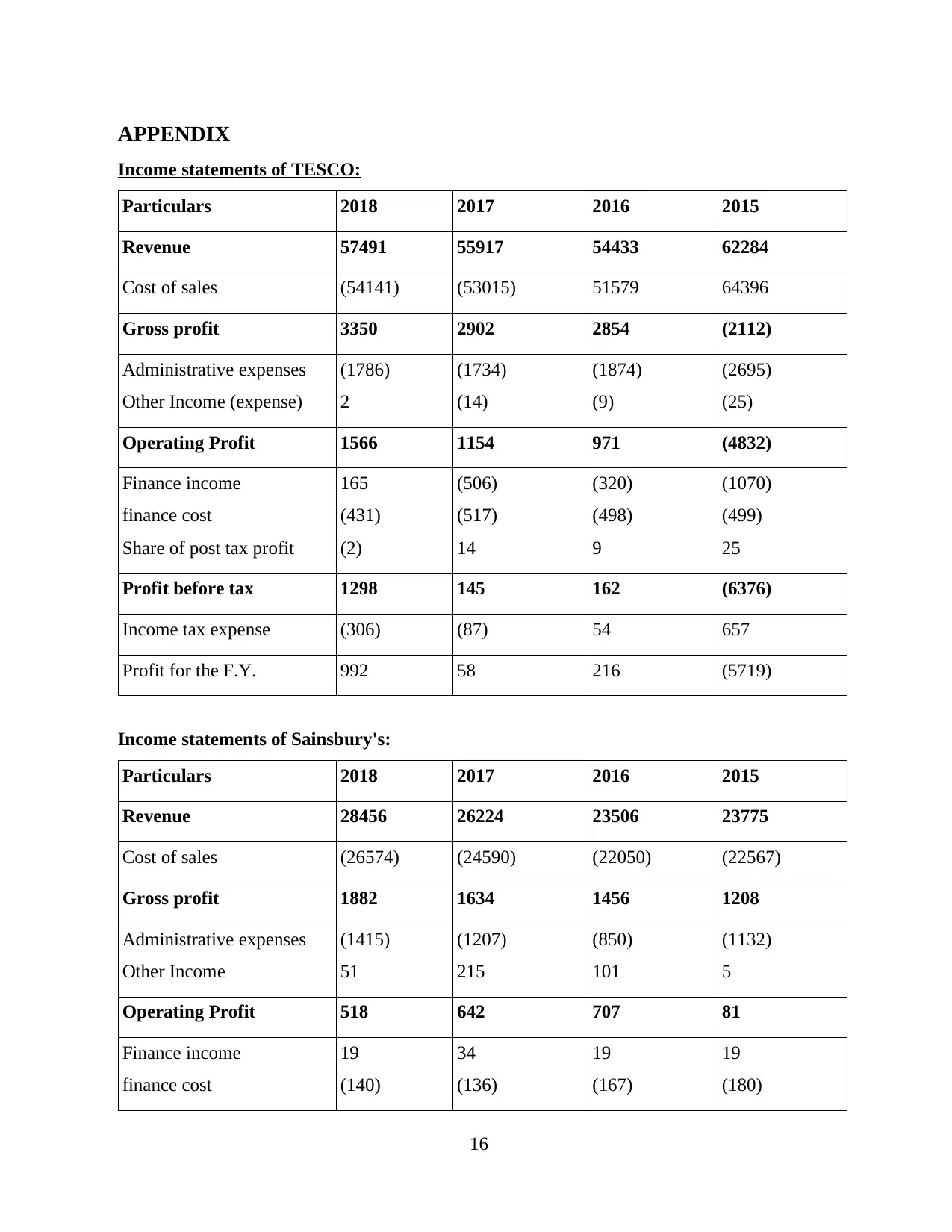
APPENDIX
Income statements of TESCO:
Particulars 2018 2017 2016 2015
Revenue 57491 55917 54433 62284
Cost of sales (54141) (53015) 51579 64396
Gross profit 3350 2902 2854 (2112)
Administrative expenses
Other Income (expense)
(1786)
2
(1734)
(14)
(1874)
(9)
(2695)
(25)
Operating Profit 1566 1154 971 (4832)
Finance income
finance cost
Share of post tax profit
165
(431)
(2)
(506)
(517)
14
(320)
(498)
9
(1070)
(499)
25
Profit before tax 1298 145 162 (6376)
Income tax expense (306) (87) 54 657
Profit for the F.Y. 992 58 216 (5719)
Income statements of Sainsbury's:
Particulars 2018 2017 2016 2015
Revenue 28456 26224 23506 23775
Cost of sales (26574) (24590) (22050) (22567)
Gross profit 1882 1634 1456 1208
Administrative expenses
Other Income
(1415)
51
(1207)
215
(850)
101
(1132)
5
Operating Profit 518 642 707 81
Finance income
finance cost
19
(140)
34
(136)
19
(167)
19
(180)
16
Income statements of TESCO:
Particulars 2018 2017 2016 2015
Revenue 57491 55917 54433 62284
Cost of sales (54141) (53015) 51579 64396
Gross profit 3350 2902 2854 (2112)
Administrative expenses
Other Income (expense)
(1786)
2
(1734)
(14)
(1874)
(9)
(2695)
(25)
Operating Profit 1566 1154 971 (4832)
Finance income
finance cost
Share of post tax profit
165
(431)
(2)
(506)
(517)
14
(320)
(498)
9
(1070)
(499)
25
Profit before tax 1298 145 162 (6376)
Income tax expense (306) (87) 54 657
Profit for the F.Y. 992 58 216 (5719)
Income statements of Sainsbury's:
Particulars 2018 2017 2016 2015
Revenue 28456 26224 23506 23775
Cost of sales (26574) (24590) (22050) (22567)
Gross profit 1882 1634 1456 1208
Administrative expenses
Other Income
(1415)
51
(1207)
215
(850)
101
(1132)
5
Operating Profit 518 642 707 81
Finance income
finance cost
19
(140)
34
(136)
19
(167)
19
(180)
16
You're viewing a preview
Unlock full access by subscribing today!
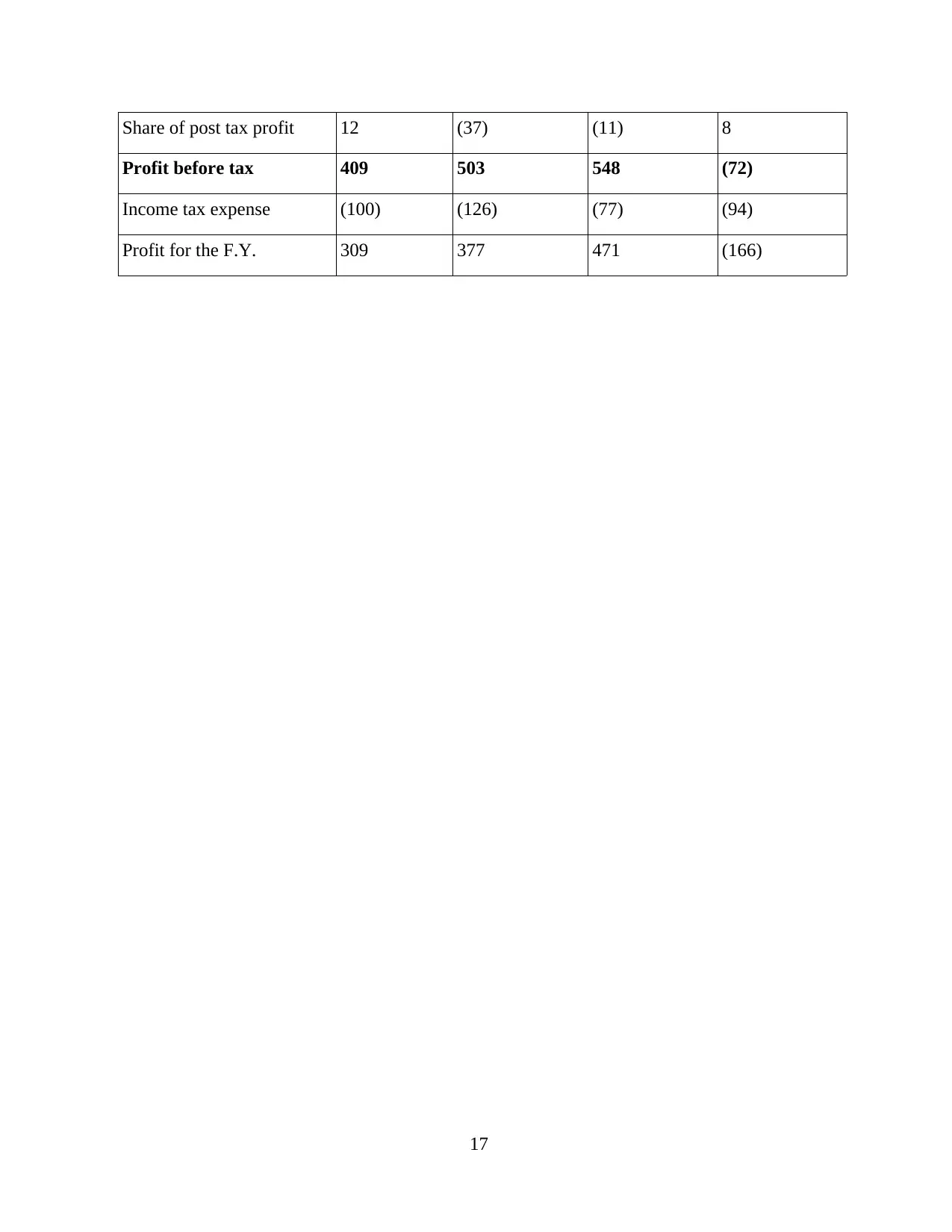
Share of post tax profit 12 (37) (11) 8
Profit before tax 409 503 548 (72)
Income tax expense (100) (126) (77) (94)
Profit for the F.Y. 309 377 471 (166)
17
Profit before tax 409 503 548 (72)
Income tax expense (100) (126) (77) (94)
Profit for the F.Y. 309 377 471 (166)
17
Paraphrase This Document
Need a fresh take? Get an instant paraphrase of this document with our AI Paraphraser
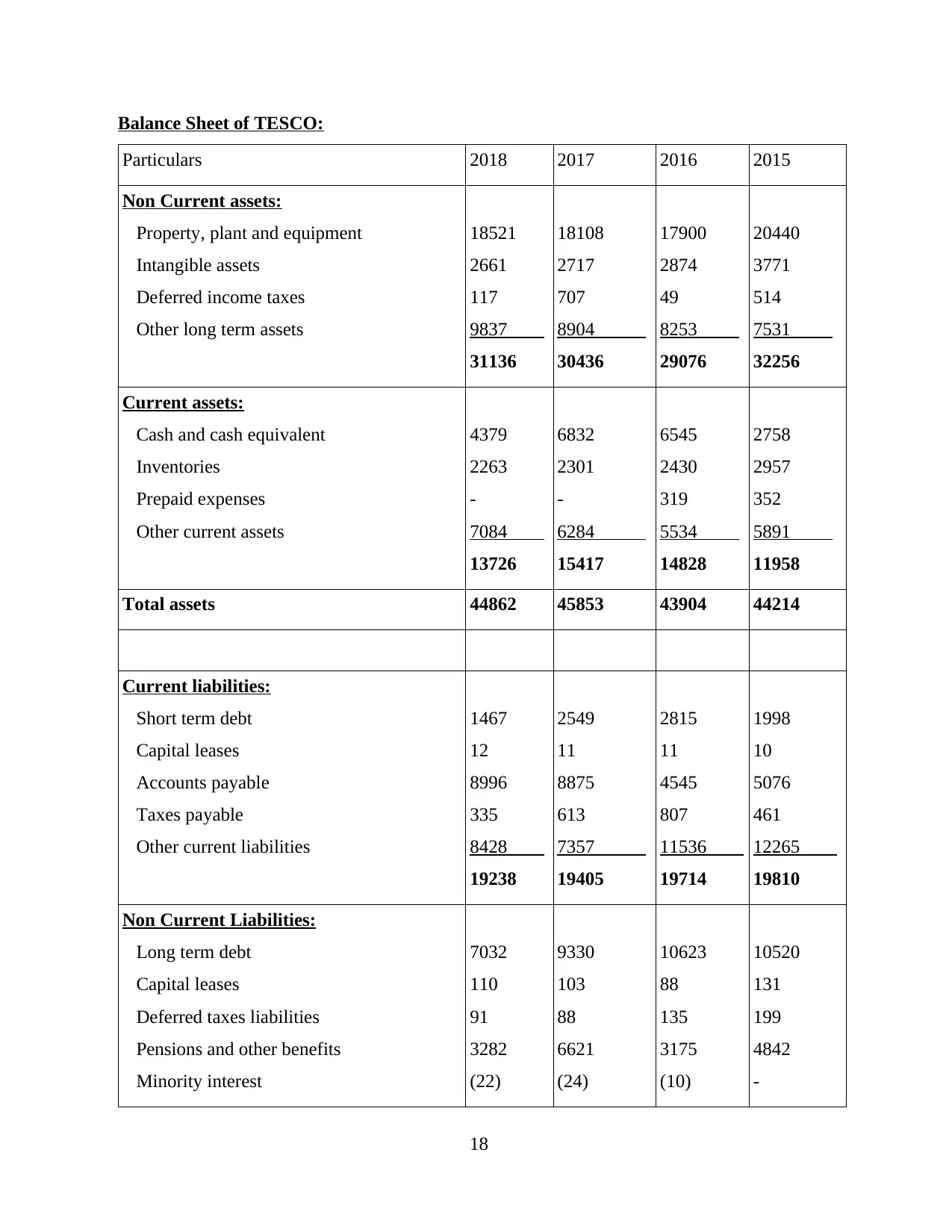
Balance Sheet of TESCO:
Particulars 2018 2017 2016 2015
Non Current assets:
Property, plant and equipment
Intangible assets
Deferred income taxes
Other long term assets
18521
2661
117
9837
31136
18108
2717
707
8904
30436
17900
2874
49
8253
29076
20440
3771
514
7531
32256
Current assets:
Cash and cash equivalent
Inventories
Prepaid expenses
Other current assets
4379
2263
-
7084
13726
6832
2301
-
6284
15417
6545
2430
319
5534
14828
2758
2957
352
5891
11958
Total assets 44862 45853 43904 44214
Current liabilities:
Short term debt
Capital leases
Accounts payable
Taxes payable
Other current liabilities
1467
12
8996
335
8428
19238
2549
11
8875
613
7357
19405
2815
11
4545
807
11536
19714
1998
10
5076
461
12265
19810
Non Current Liabilities:
Long term debt
Capital leases
Deferred taxes liabilities
Pensions and other benefits
Minority interest
7032
110
91
3282
(22)
9330
103
88
6621
(24)
10623
88
135
3175
(10)
10520
131
199
4842
-
18
Particulars 2018 2017 2016 2015
Non Current assets:
Property, plant and equipment
Intangible assets
Deferred income taxes
Other long term assets
18521
2661
117
9837
31136
18108
2717
707
8904
30436
17900
2874
49
8253
29076
20440
3771
514
7531
32256
Current assets:
Cash and cash equivalent
Inventories
Prepaid expenses
Other current assets
4379
2263
-
7084
13726
6832
2301
-
6284
15417
6545
2430
319
5534
14828
2758
2957
352
5891
11958
Total assets 44862 45853 43904 44214
Current liabilities:
Short term debt
Capital leases
Accounts payable
Taxes payable
Other current liabilities
1467
12
8996
335
8428
19238
2549
11
8875
613
7357
19405
2815
11
4545
807
11536
19714
1998
10
5076
461
12265
19810
Non Current Liabilities:
Long term debt
Capital leases
Deferred taxes liabilities
Pensions and other benefits
Minority interest
7032
110
91
3282
(22)
9330
103
88
6621
(24)
10623
88
135
3175
(10)
10520
131
199
4842
-
18
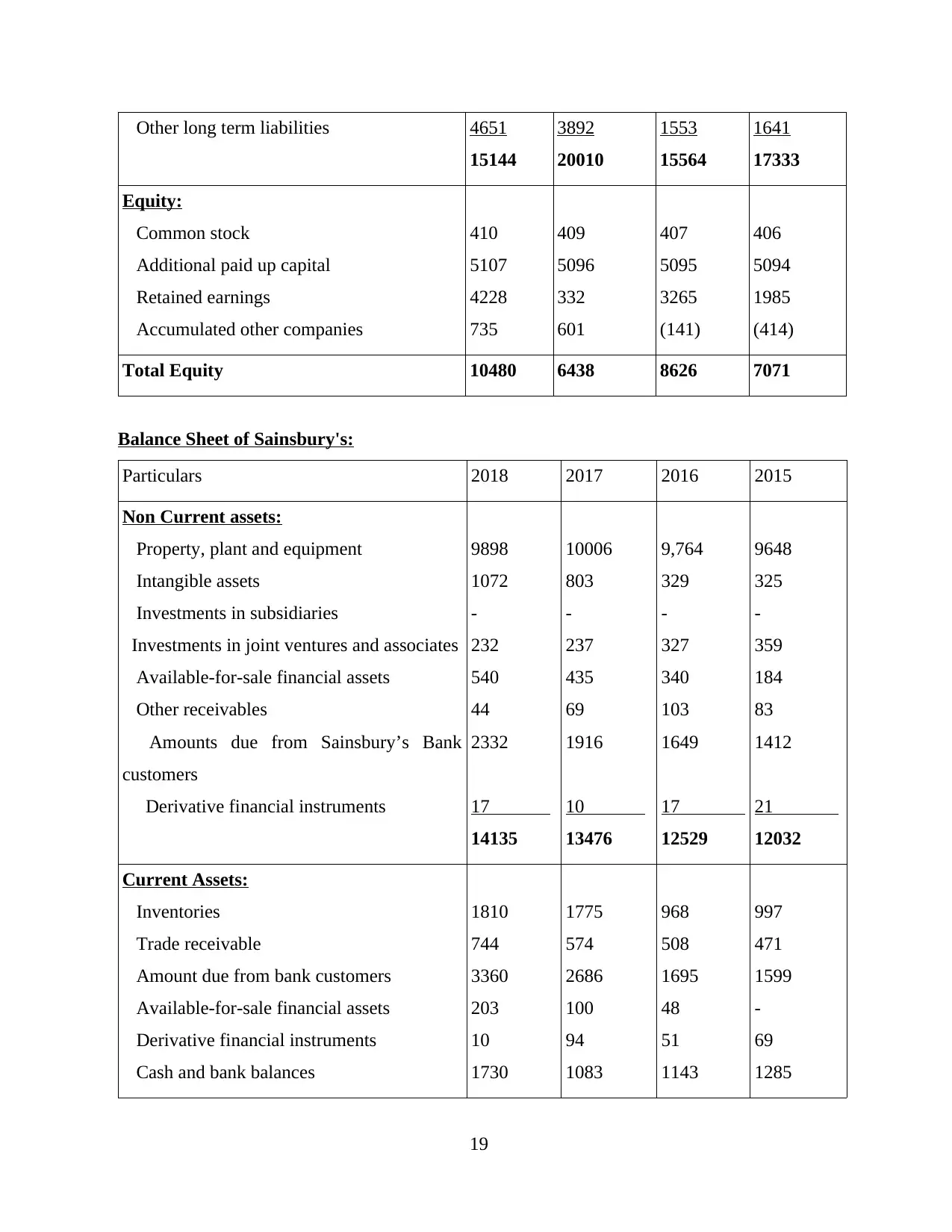
Other long term liabilities 4651
15144
3892
20010
1553
15564
1641
17333
Equity:
Common stock
Additional paid up capital
Retained earnings
Accumulated other companies
410
5107
4228
735
409
5096
332
601
407
5095
3265
(141)
406
5094
1985
(414)
Total Equity 10480 6438 8626 7071
Balance Sheet of Sainsbury's:
Particulars 2018 2017 2016 2015
Non Current assets:
Property, plant and equipment
Intangible assets
Investments in subsidiaries
Investments in joint ventures and associates
Available-for-sale financial assets
Other receivables
Amounts due from Sainsbury’s Bank
customers
Derivative financial instruments
9898
1072
-
232
540
44
2332
17
14135
10006
803
-
237
435
69
1916
10
13476
9,764
329
-
327
340
103
1649
17
12529
9648
325
-
359
184
83
1412
21
12032
Current Assets:
Inventories
Trade receivable
Amount due from bank customers
Available-for-sale financial assets
Derivative financial instruments
Cash and bank balances
1810
744
3360
203
10
1730
1775
574
2686
100
94
1083
968
508
1695
48
51
1143
997
471
1599
-
69
1285
19
15144
3892
20010
1553
15564
1641
17333
Equity:
Common stock
Additional paid up capital
Retained earnings
Accumulated other companies
410
5107
4228
735
409
5096
332
601
407
5095
3265
(141)
406
5094
1985
(414)
Total Equity 10480 6438 8626 7071
Balance Sheet of Sainsbury's:
Particulars 2018 2017 2016 2015
Non Current assets:
Property, plant and equipment
Intangible assets
Investments in subsidiaries
Investments in joint ventures and associates
Available-for-sale financial assets
Other receivables
Amounts due from Sainsbury’s Bank
customers
Derivative financial instruments
9898
1072
-
232
540
44
2332
17
14135
10006
803
-
237
435
69
1916
10
13476
9,764
329
-
327
340
103
1649
17
12529
9648
325
-
359
184
83
1412
21
12032
Current Assets:
Inventories
Trade receivable
Amount due from bank customers
Available-for-sale financial assets
Derivative financial instruments
Cash and bank balances
1810
744
3360
203
10
1730
1775
574
2686
100
94
1083
968
508
1695
48
51
1143
997
471
1599
-
69
1285
19
You're viewing a preview
Unlock full access by subscribing today!
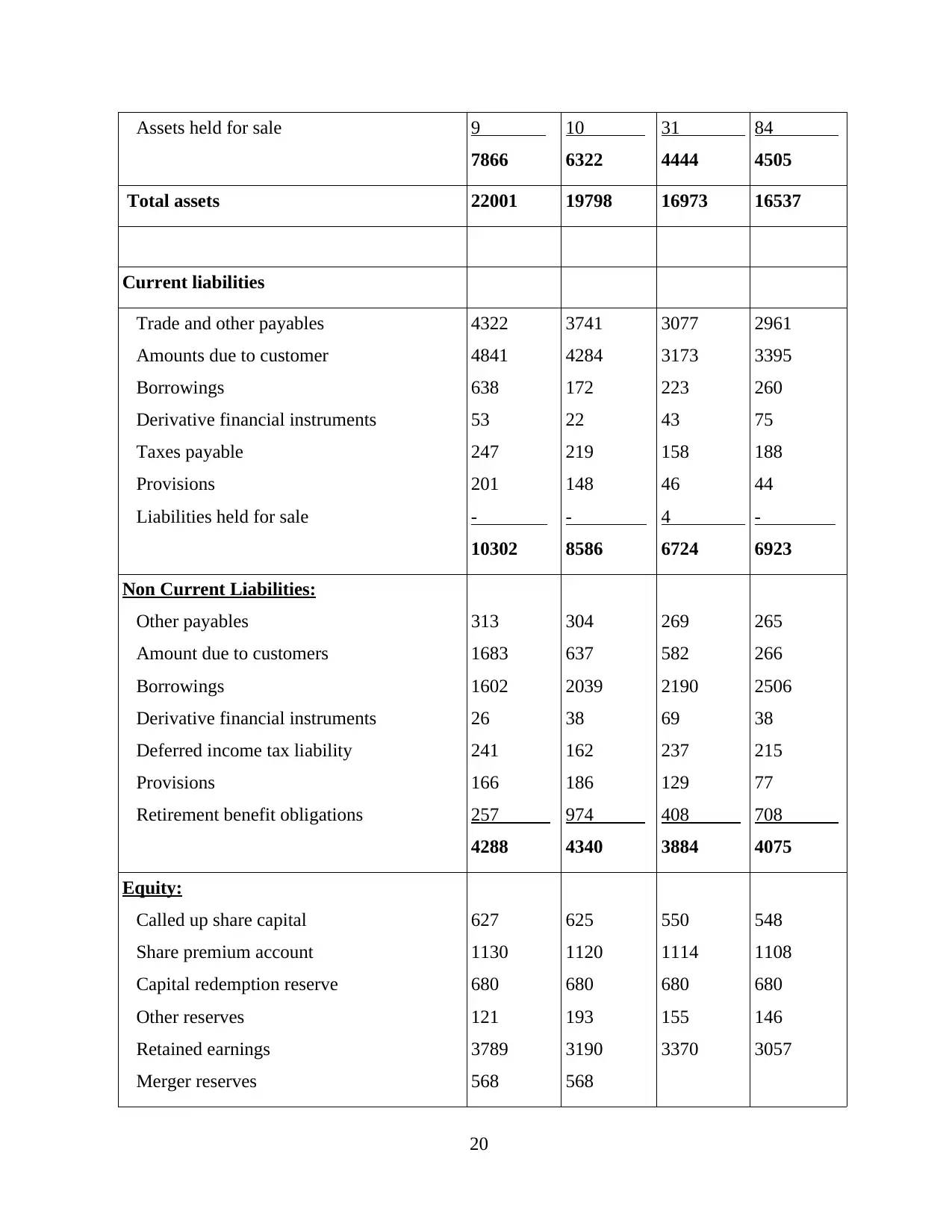
Assets held for sale 9
7866
10
6322
31
4444
84
4505
Total assets 22001 19798 16973 16537
Current liabilities
Trade and other payables
Amounts due to customer
Borrowings
Derivative financial instruments
Taxes payable
Provisions
Liabilities held for sale
4322
4841
638
53
247
201
-
10302
3741
4284
172
22
219
148
-
8586
3077
3173
223
43
158
46
4
6724
2961
3395
260
75
188
44
-
6923
Non Current Liabilities:
Other payables
Amount due to customers
Borrowings
Derivative financial instruments
Deferred income tax liability
Provisions
Retirement benefit obligations
313
1683
1602
26
241
166
257
4288
304
637
2039
38
162
186
974
4340
269
582
2190
69
237
129
408
3884
265
266
2506
38
215
77
708
4075
Equity:
Called up share capital
Share premium account
Capital redemption reserve
Other reserves
Retained earnings
Merger reserves
627
1130
680
121
3789
568
625
1120
680
193
3190
568
550
1114
680
155
3370
548
1108
680
146
3057
20
7866
10
6322
31
4444
84
4505
Total assets 22001 19798 16973 16537
Current liabilities
Trade and other payables
Amounts due to customer
Borrowings
Derivative financial instruments
Taxes payable
Provisions
Liabilities held for sale
4322
4841
638
53
247
201
-
10302
3741
4284
172
22
219
148
-
8586
3077
3173
223
43
158
46
4
6724
2961
3395
260
75
188
44
-
6923
Non Current Liabilities:
Other payables
Amount due to customers
Borrowings
Derivative financial instruments
Deferred income tax liability
Provisions
Retirement benefit obligations
313
1683
1602
26
241
166
257
4288
304
637
2039
38
162
186
974
4340
269
582
2190
69
237
129
408
3884
265
266
2506
38
215
77
708
4075
Equity:
Called up share capital
Share premium account
Capital redemption reserve
Other reserves
Retained earnings
Merger reserves
627
1130
680
121
3789
568
625
1120
680
193
3190
568
550
1114
680
155
3370
548
1108
680
146
3057
20
1 out of 22
Related Documents
Your All-in-One AI-Powered Toolkit for Academic Success.
+13062052269
info@desklib.com
Available 24*7 on WhatsApp / Email
![[object Object]](/_next/static/media/star-bottom.7253800d.svg)
Unlock your academic potential
© 2024 | Zucol Services PVT LTD | All rights reserved.





